Portuguese desserts and pastries are a passion that we regularly enjoy in our adopted home city of Lisbon. Discover our favorite sweet treats in Portugal.
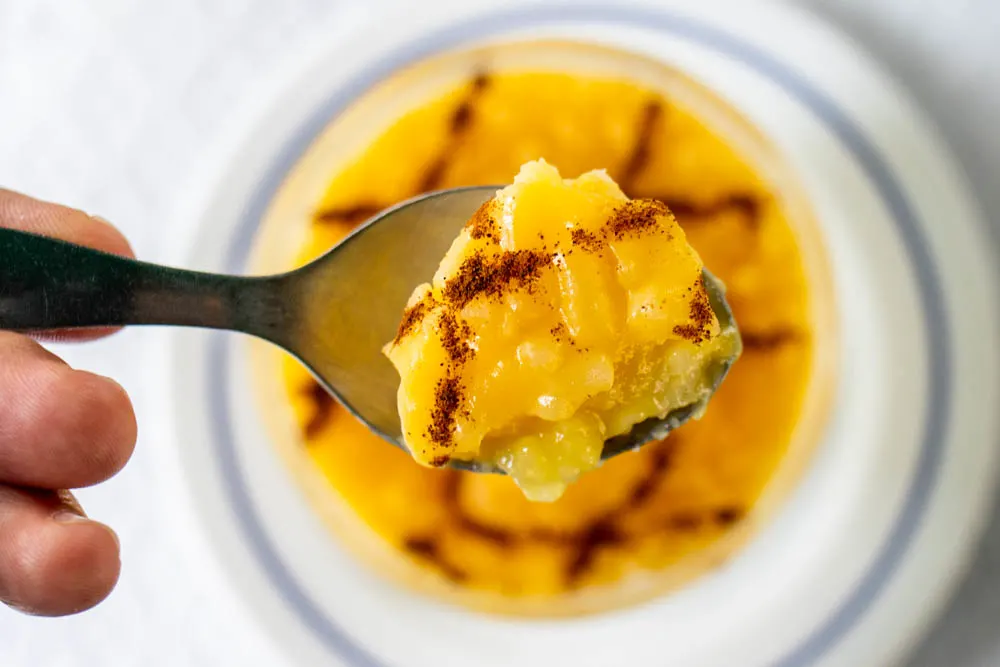
We didn’t move to Lisbon because of the Portuguese capital’s obsession for sweet treats but we’re not complaining. Like the rest of the Iberian country, Lisbon has a seemingly endless number of pastelerias (pastry shops) and even more pastéis (pastries).
What Makes Portuguese Desserts Unique?
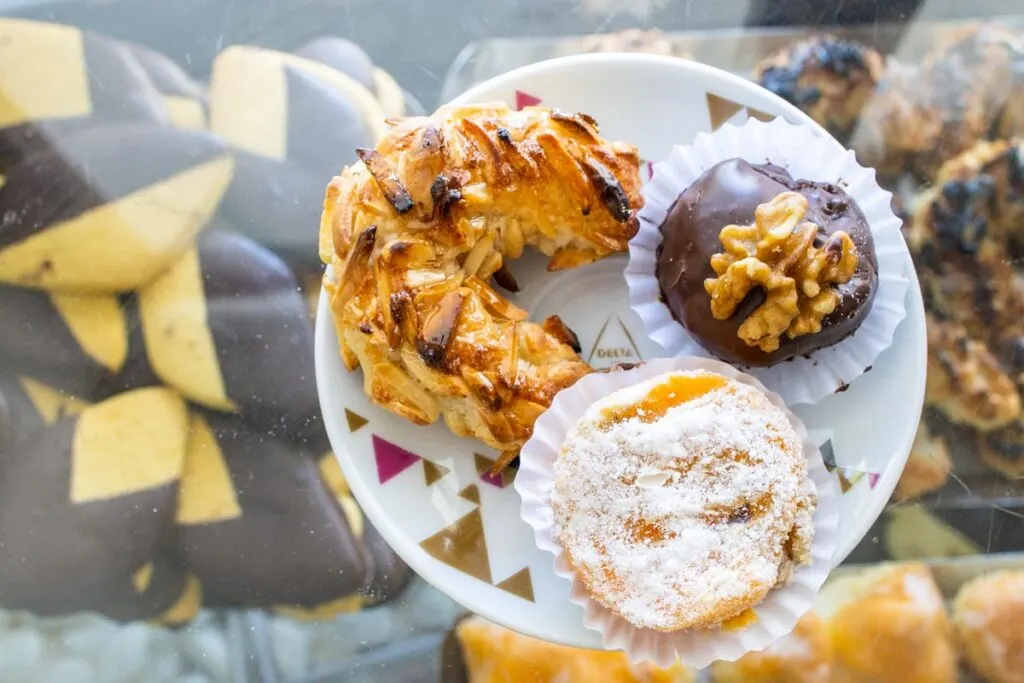
There’s no debate that the Portuguese have a thing for sugar and eggs. These two ingredients are prevalent in many but not all Portuguese dessert recipes including the country’s most famous pastel (pastry) – the Pastel de Nata.
The Pastel de Nata was famously invented at Mosteiro dos Jerónimos in the 18th century before later achieving international dessert fame. Other doces conventuais (convent sweets) were invented in monasteries across the country even earlier.
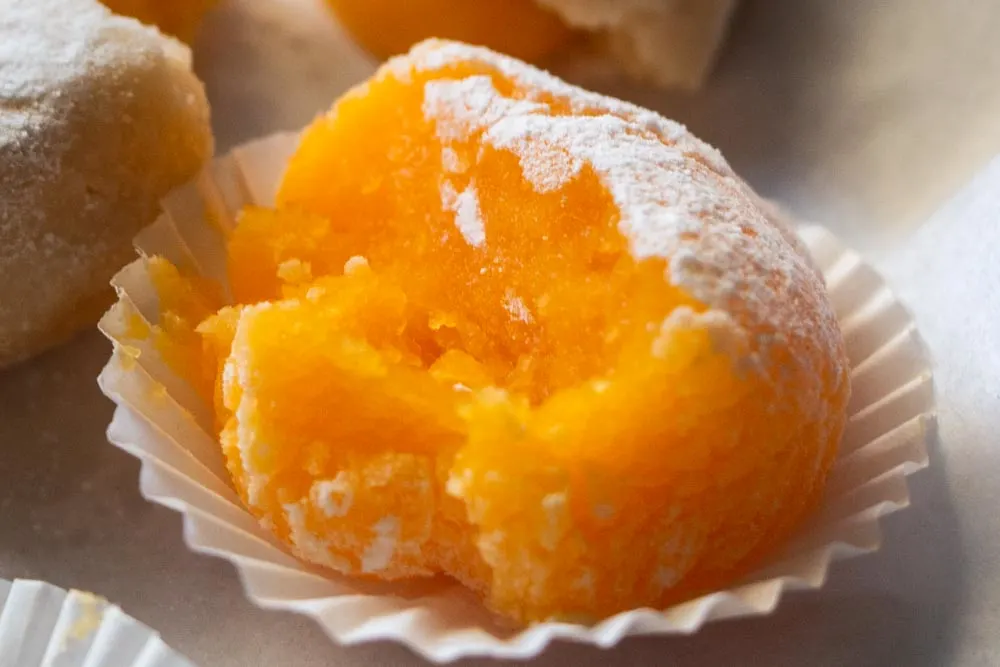
Egg yolks became a common ingredient at that time due to nuns using egg whites to starch their habits. Walk up to a Portuguese pasteleria counter today and you’ll find a variety of beautiful golden hued pastries in between local versions of croissants, donuts and cookies.
Lisbon is literally filled with pastelerias, often more than one on a city block, each selling a range of pastries and super sweet treats. And that’s not counting desserts served in Lisbon restaurants.
Read our Lisbon restaurant guide.

This situation creates a challenge when we eat dessert in our adopted home city. Should we order a Pastel de Nata, still the most popular local pastry available pretty much everywhere in Portugal, or should we try something different like Arroz Doce? Though we often choose option number one, sometimes we go rogue without any regret.
We don’t just eat pastries in Portugal! Discover more than 100 amazing sweet treats around the world.
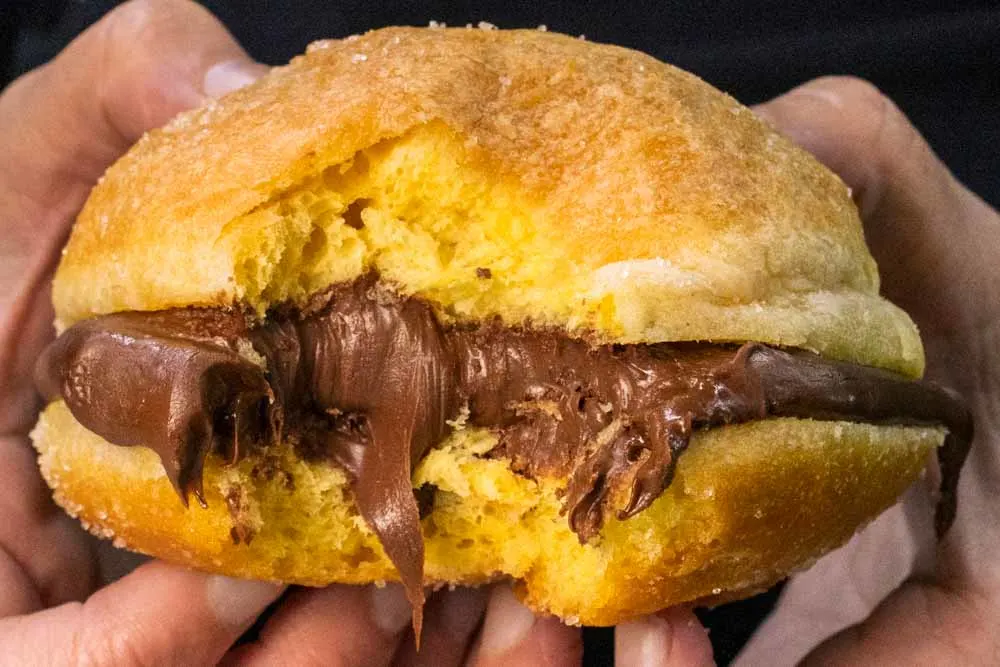
We’ve made a point to eat lots of Portugal desserts for ‘research purposes’ since we moved to Lisbon in 2019 and it’s one of our favorite aspects of living in Portugal. In this guide, we share our favorite Portuguese pastries and desserts including some with international ties and one that will surprise you.
Discover inspirational desserts in France, Germany and Italy.
Our Favorite Portuguese Desserts
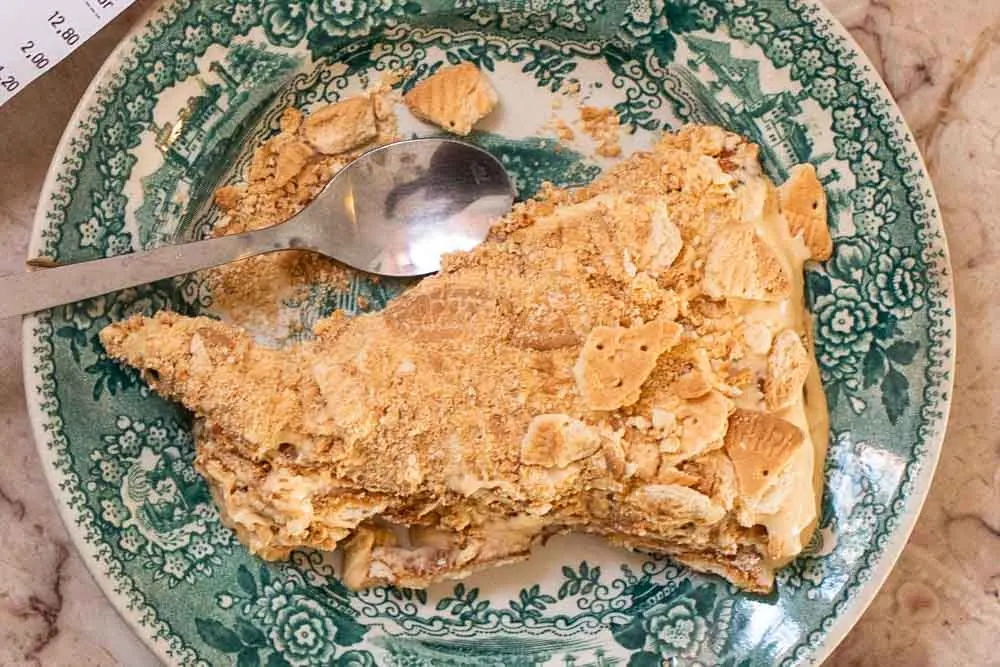
We mentioned that the Portuguese people love desserts and we weren’t exaggerating. Pretty much every Portuguese menu has a sobremesa (dessert) section fill with cake, pudding and more. The number of Portuguese dessert recipes is astounding.
Many of these desserts are filled with egg yolks and sugar but plenty feature ingredients like chocolate and almonds. Some of the best are specific to Portugal while others are global in both origin and popularity.
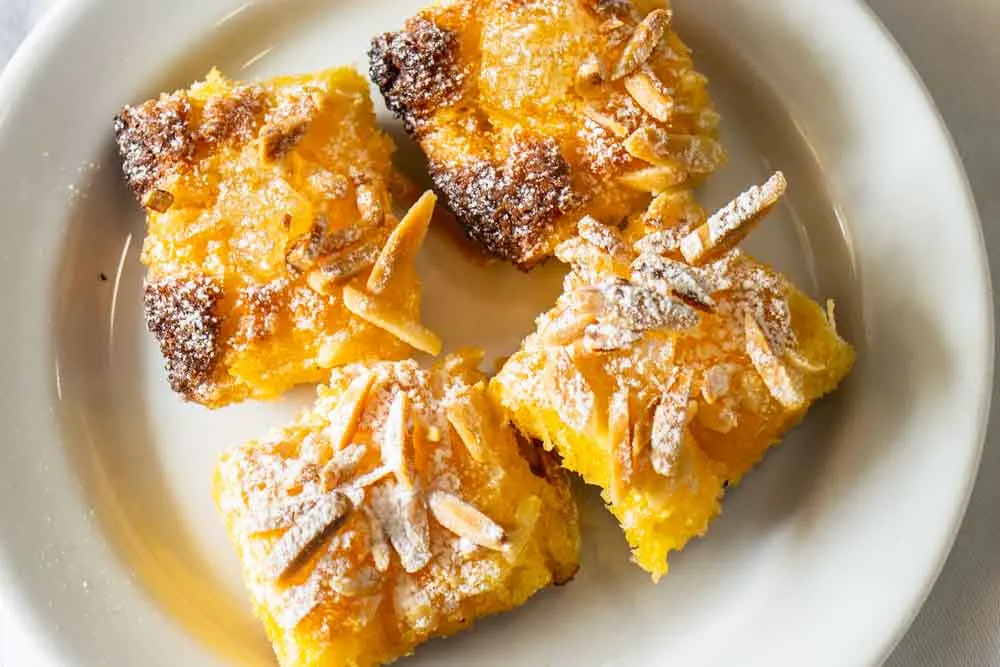
Tasting Portuguese desserts has become a bit of a passion project for us. After eating our collective weight in desserts both at home in Lisbon and in destinations like Cascais, Coimbra, Évora, Porto, Sintra and the Algarve, these are our favorite desserts in Portugal:
1. Bolo De Bolacha e Caramelo (Biscuit and Caramel Cake)
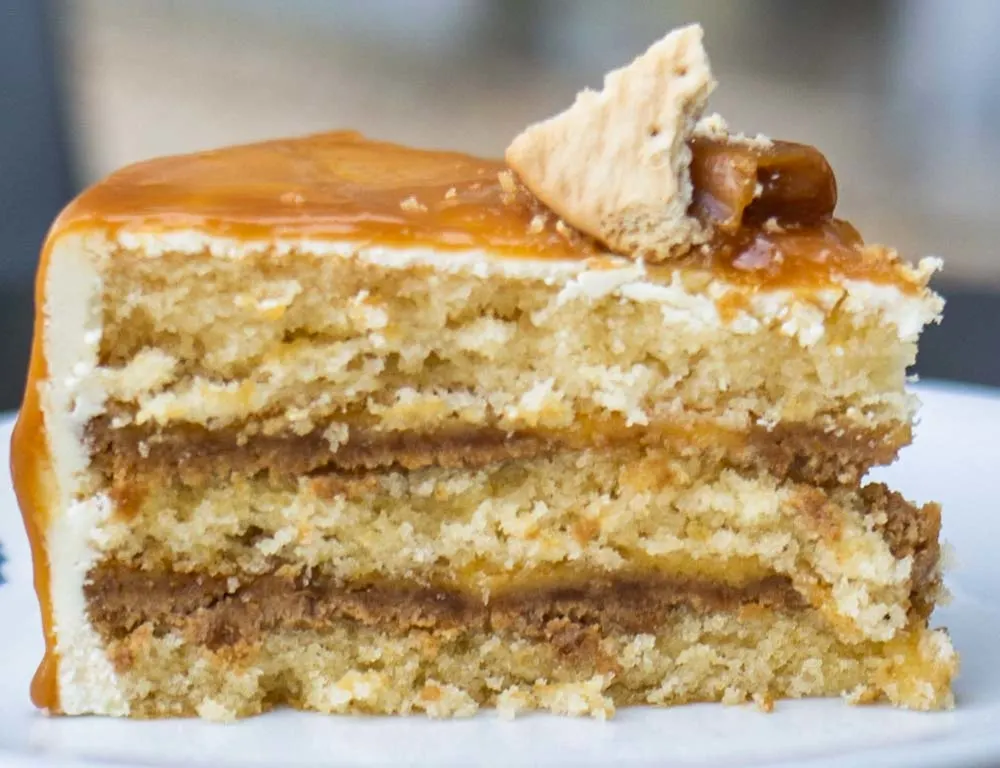
Flavored with both wafers and caramel, Bolo de Bolacha e Caramelo provides a practical solution when deciding between a cookie or cake. The name of this dessert literally translates to Wafer Cake with Caramel. When done right, it’s that and so much more.
Our obsession with this Portuguese cake can’t be understated. Bolo de Bolacha e Caramel is now Mindi’s official Portuguese birthday cake. Daryl is sticking with Bolo de Chocolate since he’s more of a chocolate cake fan.
2. Bolo De Chocolate (Chocolate Cake)
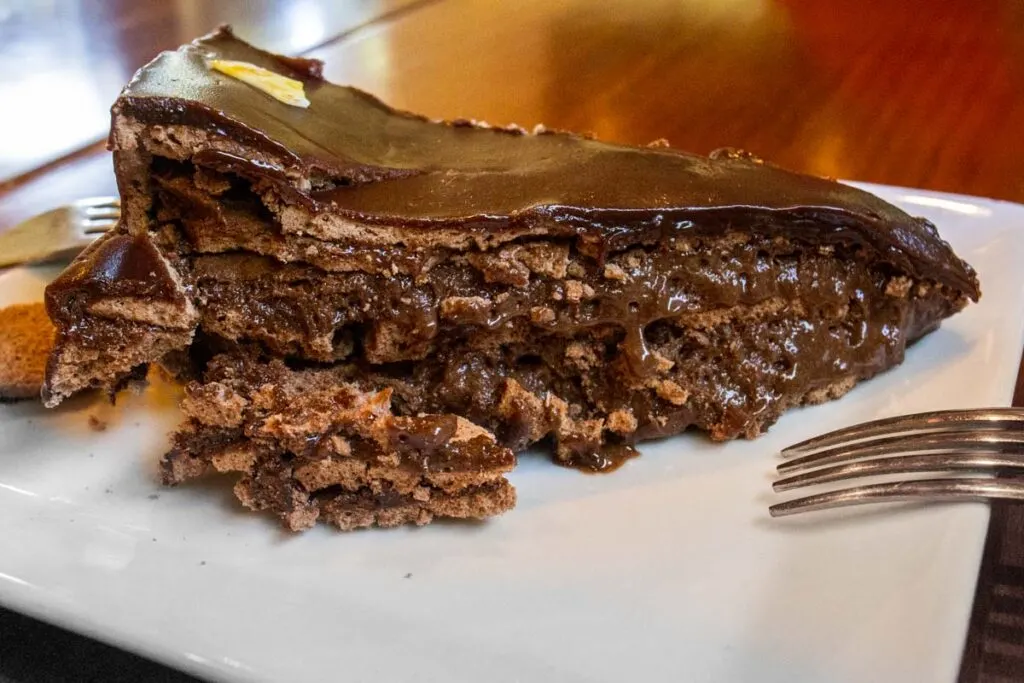
Chocolate cake is a dessert that spans the world despite the fact that cocoa beans only grow in equatorial countries like Ghana, Indonesia and Brazil. Although Portugal isn’t one of these countries, chocolate is prevalent in various shapes and forms throughout the Iberian country.
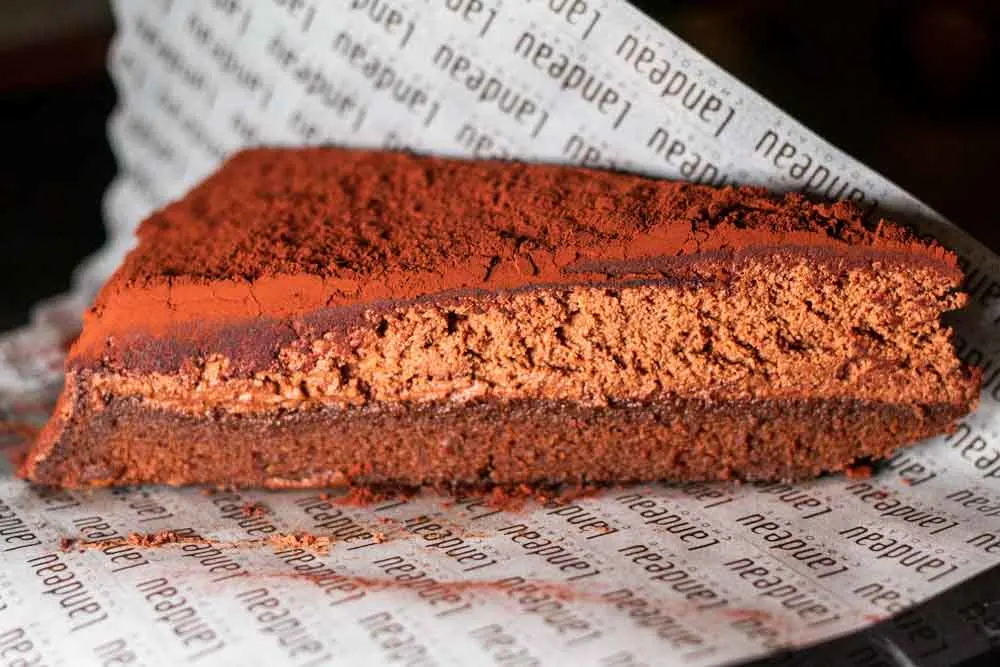
Chocolate lovers who visit Portugal won’t want to skip Landeau Chocolate where bakers create the cafe’s signature Bolo de Chocolate, i.e. chocolate cake, with three chocolate layers – cake, mousse and powder. Both the New York Times and Food and Wine agree that Landeau’s version, which sandwiches rich mousse between two tender layers of cake, is the chocolate cake to eat in Portugal.
3. Arroz Doce (Rice Pudding)
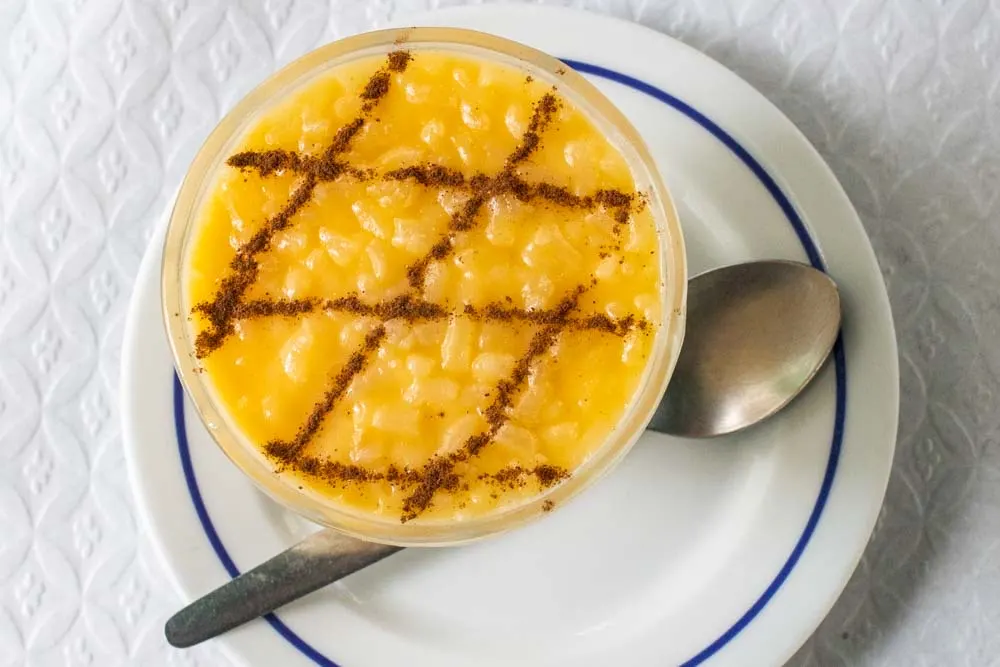
Similar to chocolate, rice pudding is popular in countries around the world. The Portuguese version called Arroz Doce, which literally translates to sweet rice, lives up to its name with a rich yellow egg hue and texture that differentiates it from similar versions in countries like Greece.
Portugal’s Arroz Doce recipe includes short-grain rice in addition to egg yolks, milk, sugar and lemon peel. Typically decorated with a cinnamon checkerboard design, the creamy dessert is a hallmark of Portuguese Sobremesas (desserts).
4. Pudim Abade De Priscos (Abbot Of Priscos’ Pudding)
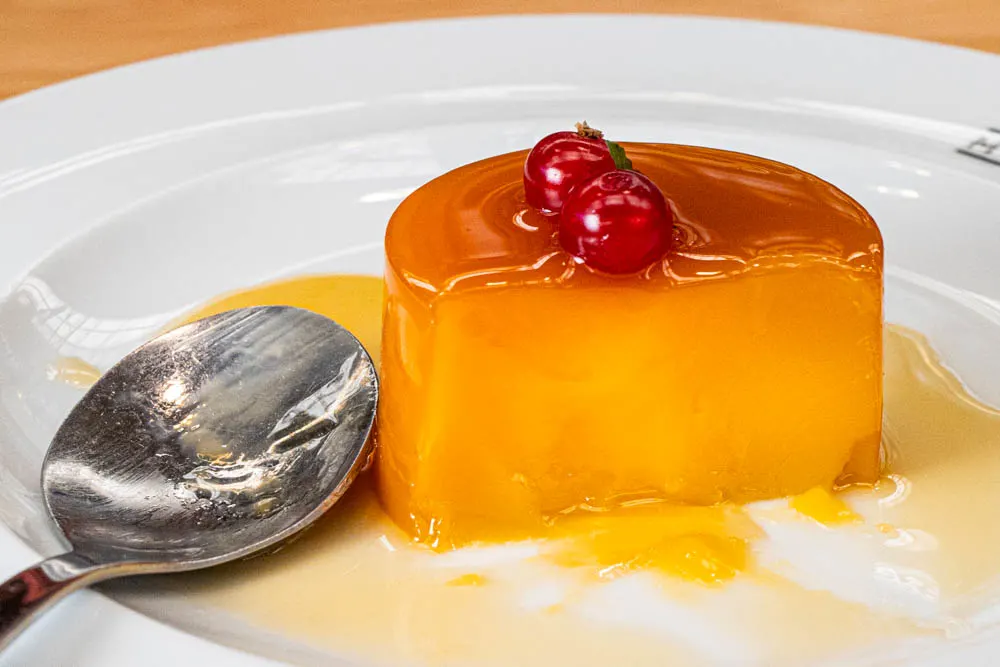
Portuguese clergy didn’t only bake pastries and cakes back in the day. Father Manuel Joaquim Machado Rebelo, i.e. the Abbot of Priscos, invented one of the country’s best desserts in the 19th century… and it’s a pudding.
In addition to the expected egg yolks and sugar, Pudim Abade de Priscos has port wine and bacon in its ingredient roster. Although its roots are in Northern Portugal, the rich pudding (think of a richer, less gelatinous version of Spanish Flan) is available throughout the country.
Pro Tip
Even if you’re full, we urge you to order a Pudim Abade de Priscos when you see it on a Portuguese dessert menu. It’s that good.
5. Bolo Rei (King Cake)
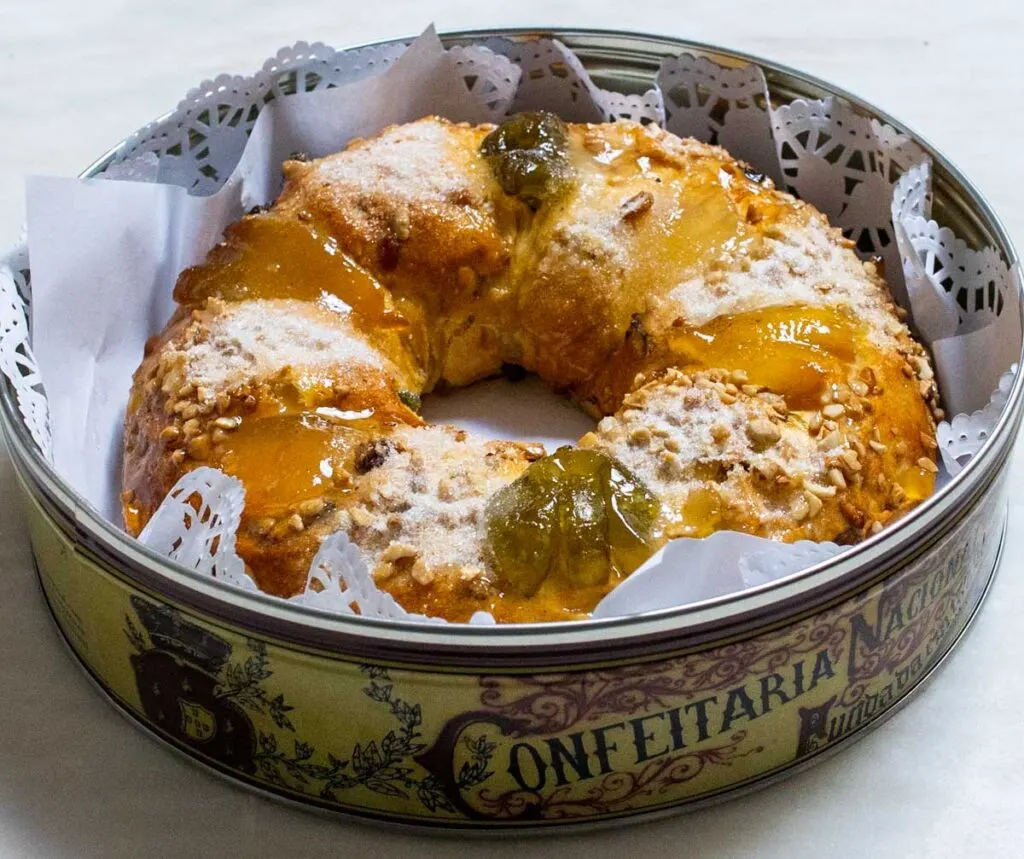
Bolo Rei is the king of holiday desserts in Portugal – and we’re not just saying this because Bolo Rei translates to king cake. These cakes line the shelves at pastry shops and markets throughout the country during the extended holiday season that lasts from late October to early January. If you visit Portugal during Natal, these colorful cakes are almost impossible to avoid.
We first encountered Bolo Rei in Porto during a mid-November visit and later bought a big ring topped with candied fruits. While not our favorite Portuguese dessert due its dry texture, this holiday cake completes a Portugal evening filled with eggnog and Christmas carols.
6. Leite Creme (Cream Milk)
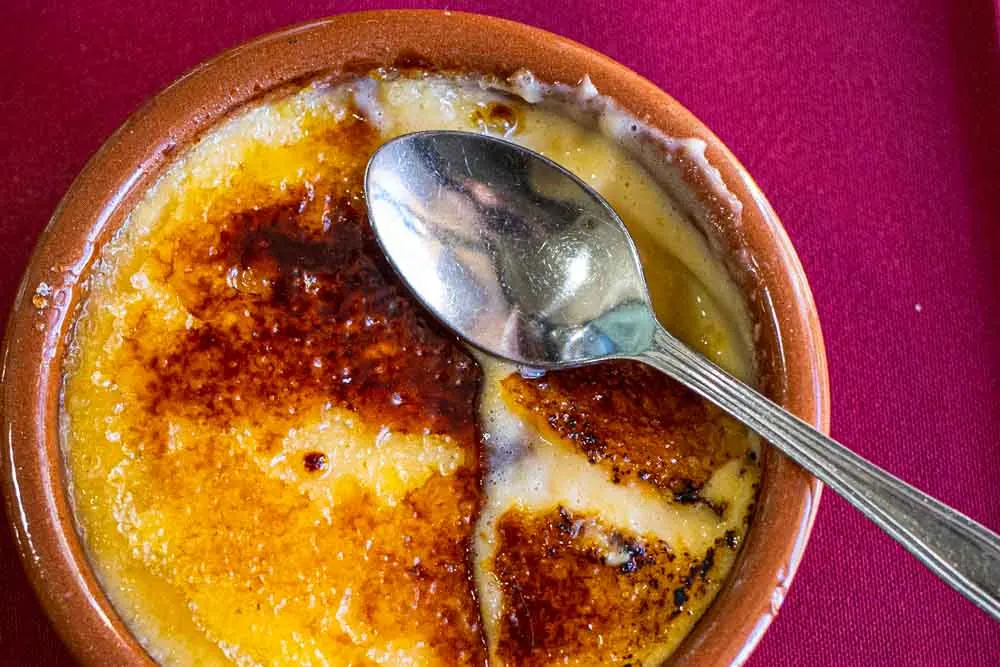
Although Portuguese chefs weren’t the first to top custard with caramelized sugar, the country has adopted the global dessert as its own. After eating similar versions in England (Burnt Cream), France (Crème Brûlée) and Spain (Crema Catalana), we consider Portugal’s Leite Creme to be closest to the Spanish version.
In Portugal, both casual eateries and fancy restaurants serve Leite Creme, a creamy dessert with hints of both lemon and cinnamon. Not surprisingly, egg yolks and sugar are also in the mix.
7. Bolo De Queijo (Cheesecake)
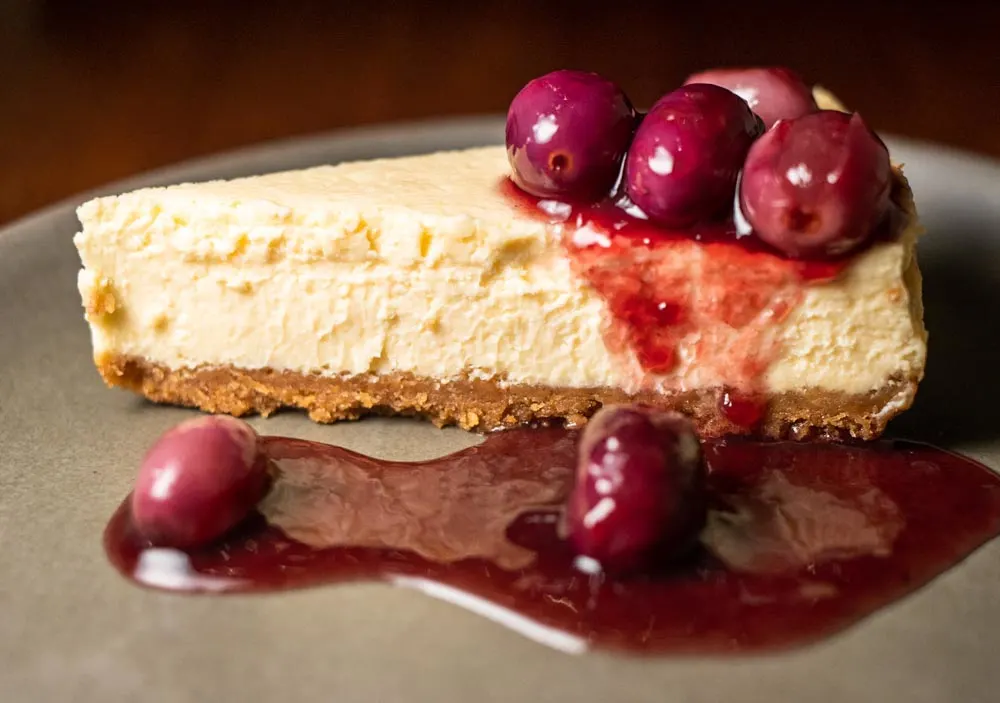
Cheesecake is most associated with New York City. And while the dessert may have been refined and perfected in the big apple, it’s actually a global dessert that likely originated in ancient Greece. Fans of this dessert will be happy to find it in Portugal too.
The best way to eat cheesecake in Portugal is to order a slice of Bolo de Queijo topped with port sauce. Since this fortified wine is exclusively produced in Portugal’s Douro Valley, adding port sauce transforms cheesecake from global to Portuguese.
8. Mousse de Chocolate (Chocolate Mousse)
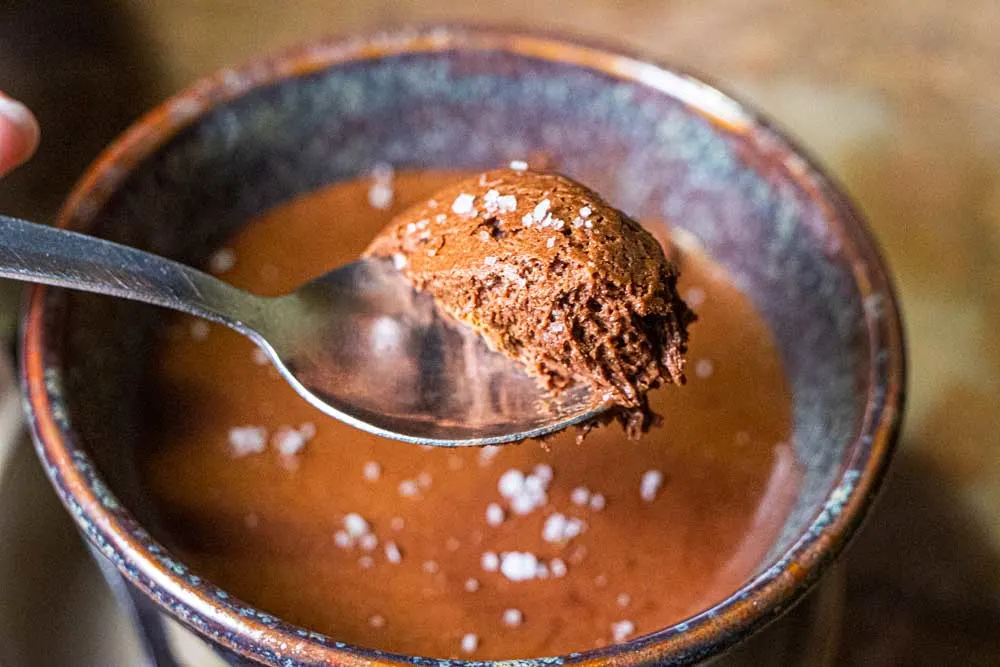
Mousse de Chocolate is a dessert that made its way to Portugal after traveling the world. However, unlike other desserts, chocolate mousse has a definitive origin – France.
This journey is no surprise considering that two of the key ingredients in chocolate mousse are eggs and sugar. Adding chocolate and butter is not much of a stretch and makes perfect sense in this dessert-friendly nation.
9. Bolo de Maçã (Apple Cake)
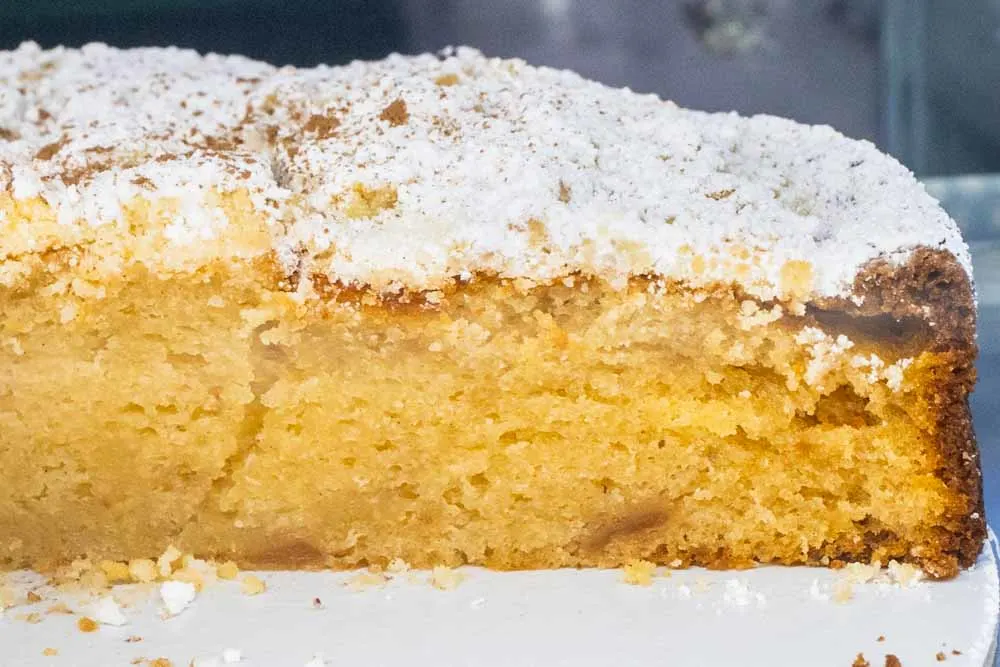
Apples are grown throughout Portugal but the best apples can be found in Alcobaça orchards near Lisbon. Our favorite Portuguese apples are Fuji and Royal Gala; however, any local apples taste good in a Bolo de Maçã recipe.
Baked with ingredients found in a typical Portuguese pantry, Bolo de Maçã is the apple cake our grandmothers would have baked if they were born in Portugal. In addition to apples, this cake features ingredients like sugar, flour, butter and eggs.
10. Bolo Xadrez (Chess Cake)
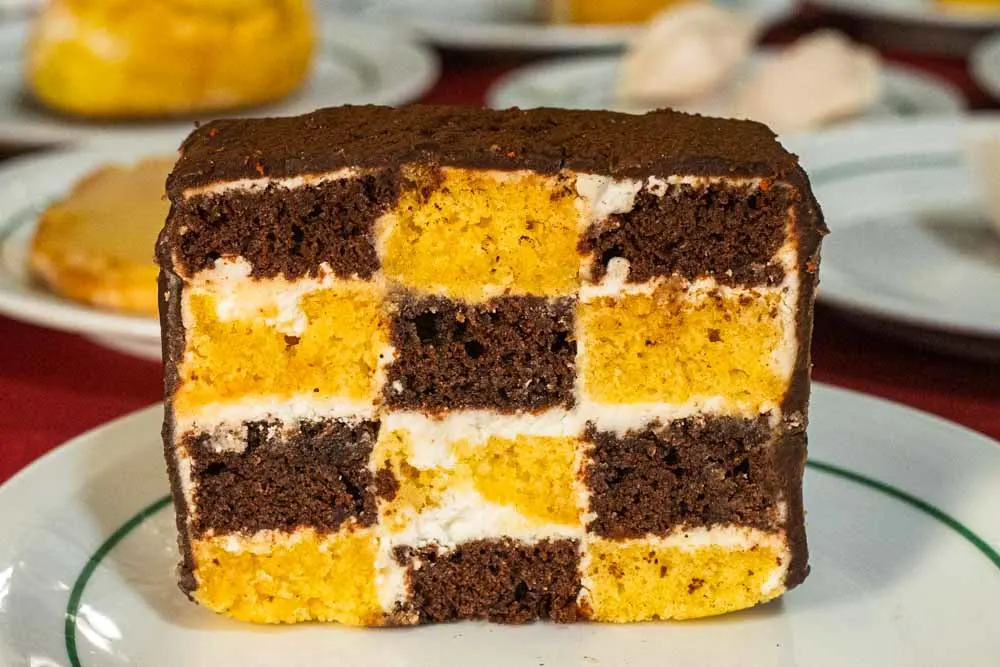
More complicated than a typical Portuguese dessert, Bolo Xadrez layers yellow and chocolate sponge cake in a checkerboard design, separates the layers with cream and coats them in chocolate icing. This certainly isn’t a dessert we’d want to bake at home, but that’s not an issue in Portugal.
We ate Bolo Xadrez for the first time soon after we watched The Queen’s Gambit. Not only did the Netflix show inspire us to craft Gibson cocktails at home, but it also motivated us to order a slice of this chess board cake at a Lisbon pasteleria. We’re glad on both counts.
11. Toucinho do Céu (Bacon of Heaven)
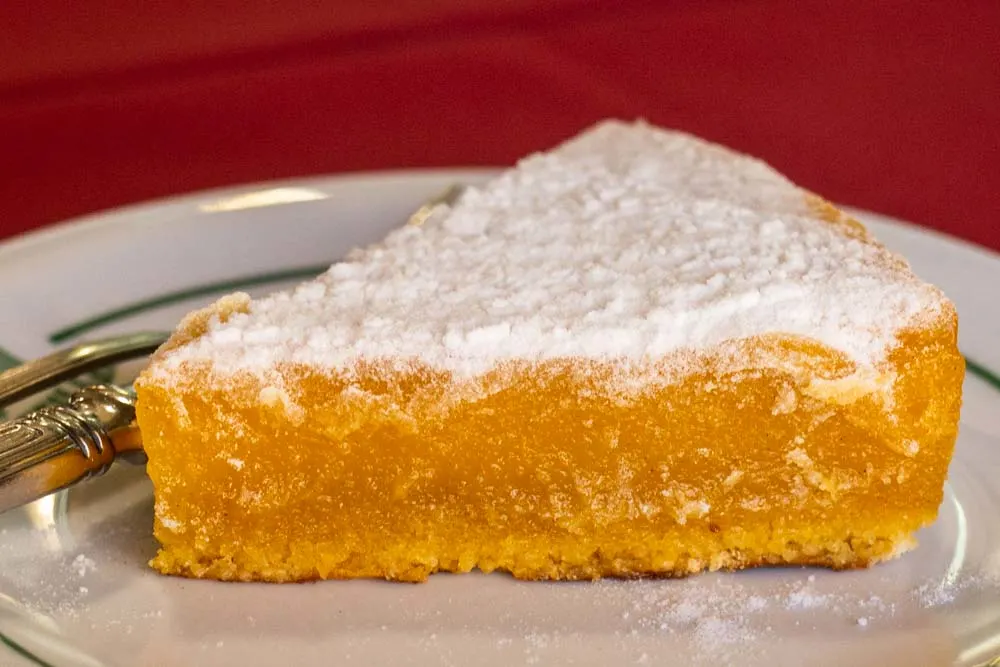
Toucinho do Céu intrigued us before we took our very first bites of the luscious dessert. Considering that its name translates to bacon from heaven, this intrigue was inevitable since bacon is one of our favorite foods.
Invented by Guimarães nuns in the Braga district during the 18th century, this cake’s name derives from pork fat that was used in its original recipe. Although that ingredient is now optional, the name stuck. Non-optional ingredients include lots of sugar and eggs as well as ground almonds and butter.
12. Bolo De Mel (Honey Cake)
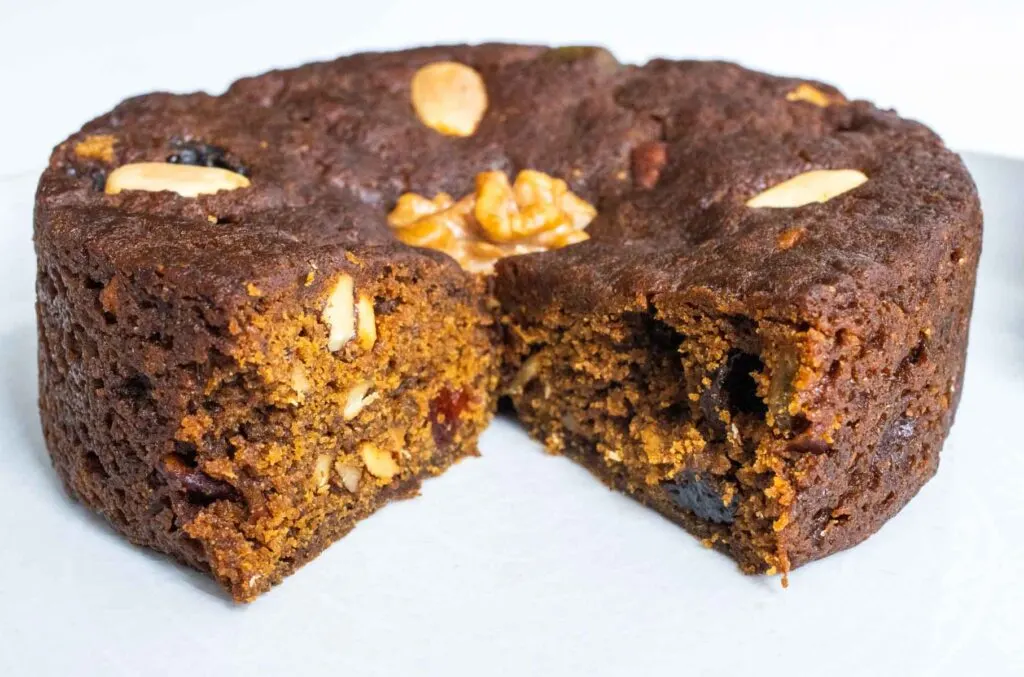
Bolo de Mel is an iconic Madeira cake that dates back to the 15th century when Portugal was a major player in the spice trade. The sweet cake’s ingredient list includes honey (or molasses) as well as spices like cinnamon and clove. It’s popular all year round but especially during the holiday season.
Discover more great things to eat in Madeira.
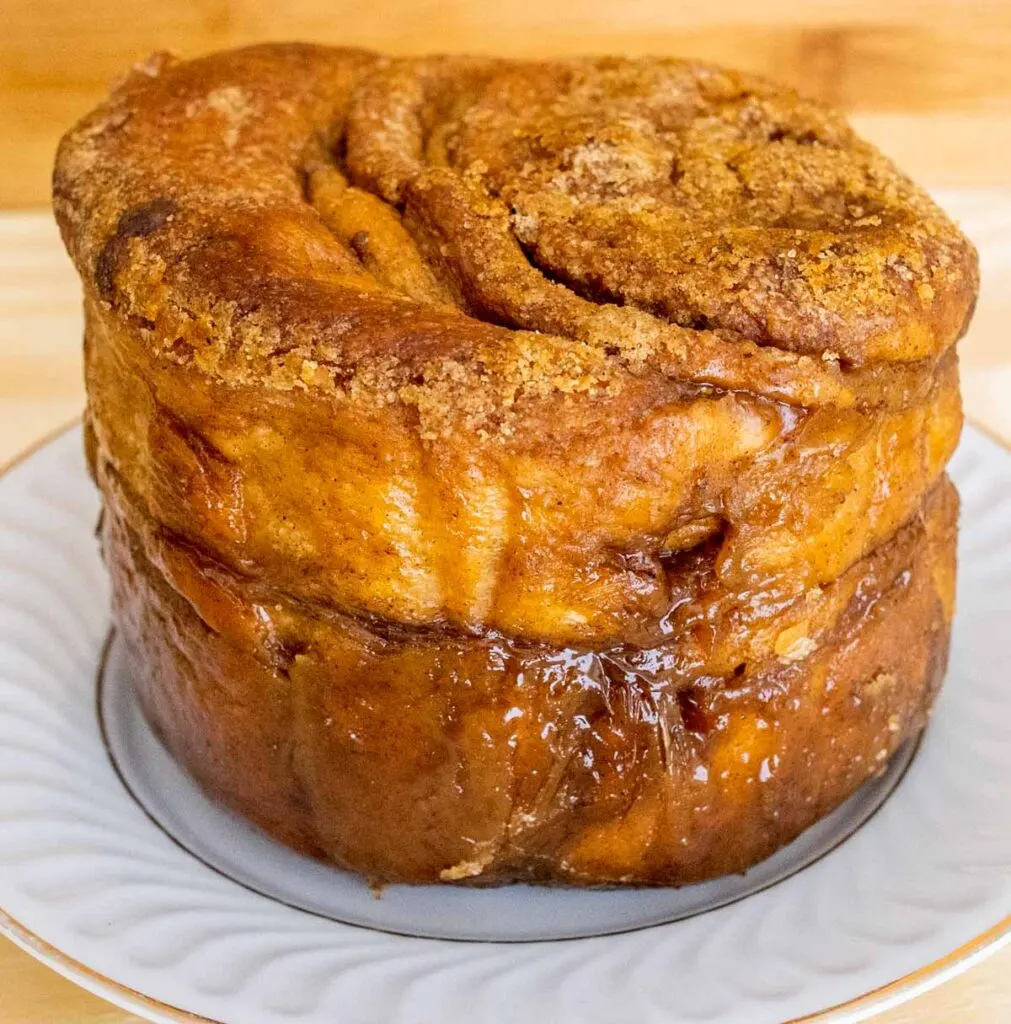
However, Madeira isn’t the only Portuguese region that bakes Bolo de Mel. We found a wonderful Bolo de Mel in the Algarve town of Olhão. The honey cake we ate in the seafaring town delighted us with its soft center and ooey gooey coating.
13. Torta de Amêndoa (Almond Pie)
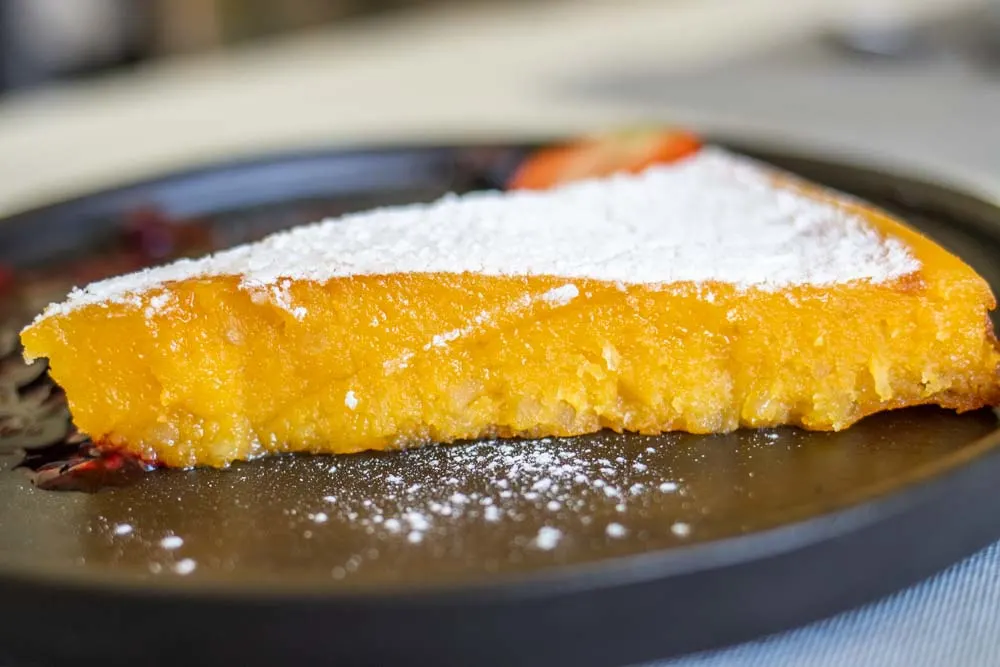
Torta de Amêndo is a great option for those who love sweet almond desserts but don’t eat pork. In all honesty, it’s not that different from Toucinho do Céu except for the latter’s controversial ingredient.
This difference doesn’t sway us either way since we like both desserts. However, we appreciate that Torta de Amêndo is the better option for our Vegetarian and Kosher readers.
14. Gelado (Gelato)

The Portuguese didn’t revolutionize modern ice cream. That credit goes to Italy. This situation doesn’t stop Gelado from being one of the most popular desserts in Portugal among kids of all ages.
Perhaps ice cream is so popular because the best Portuguese Gelado makers have connections to Italy. Some claim Italian heritage while others honed their craft at Carpigiani Gelato University in Bologna. Although many of the country’s top gelaterias are in Lisbon, restaurants and shops serve tasty scoops of Gelado all over the country.
Read our Lisbon ice cream guide.
Our Favorite Portuguese Pastries
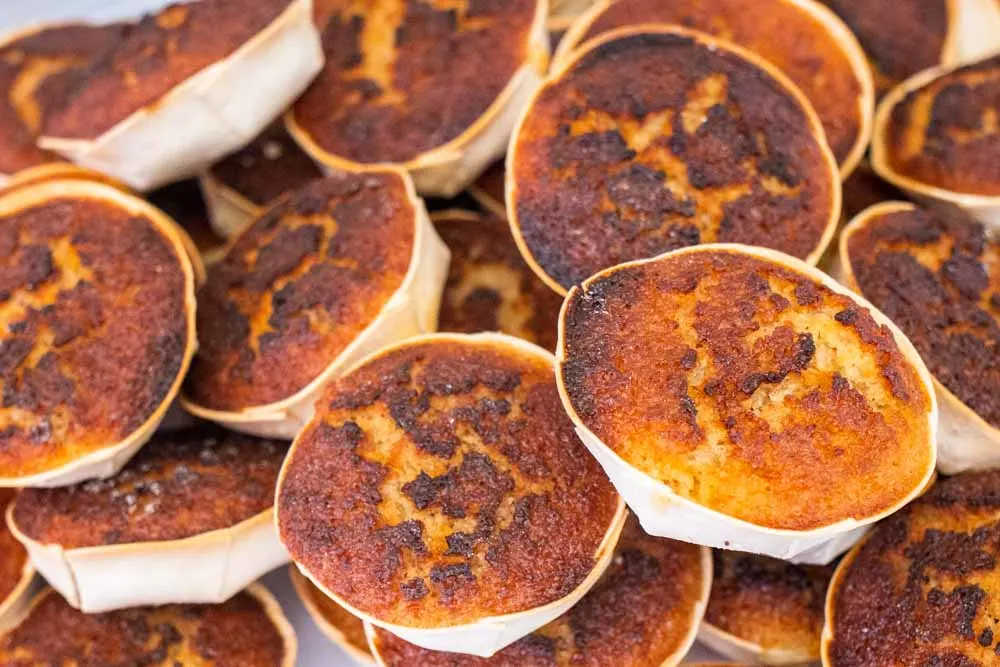
If you can’t find pastries in Portugal, then you’ve failed in your sweets finding mission.
Every time we eat a new pastry in Portugal, we find two more to try. We’d eat them all in one sitting, but then we’d get sick. However, that being said, we’ve eaten a preponderance of traditional Portuguese pastries since our first visit more than 13 years ago.
Though our Portugal pastry mission continues as we explore the country through its food, these traditional Portuguese pastries are the ones we crave most:
15. Pastel de Belém
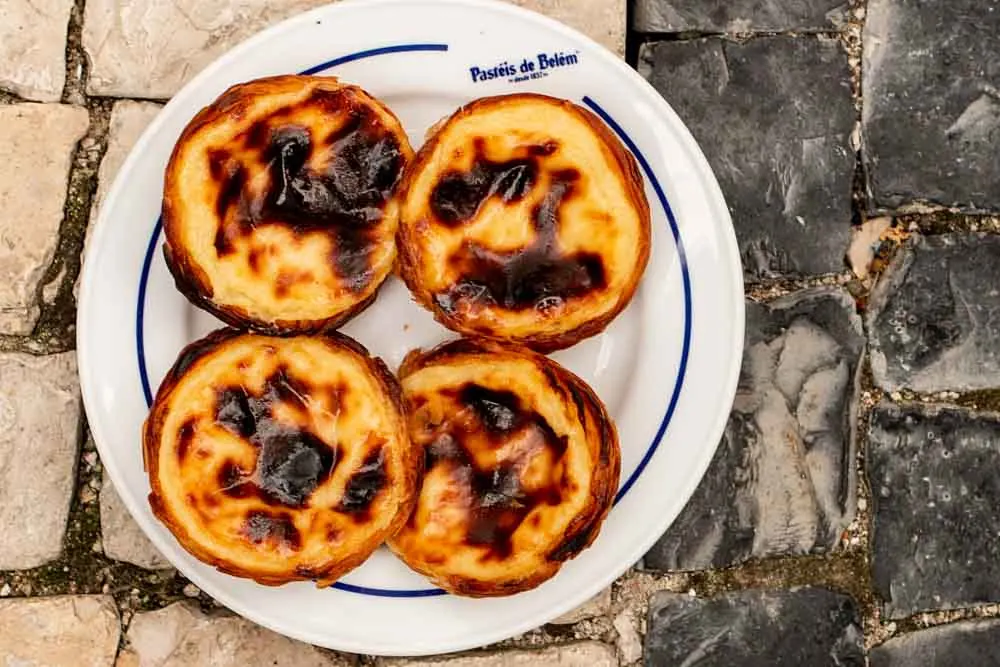
The Pastel de Belém is special. Not only was this egg tart the gateway convent pastry that ignited our sweet Portuguese obsession, but the Pastel de Belém is also Portugal’s signature pastry.
Legend has it that monks invented the Pastel de Belèm in the 18th century using yolks left over at Mosteiro dos Jerónimos from egg whites used to starch habits. After securing the historic Pastel de Nata recipe, Fábrica de Pastéis de Belém has continued the sweet tradition for almost two centuries.
Although Pasteis de Nata are available in every corner of Portugal, there’s only one place to eat the original incarnation. Luckily for you and us, Belém is just a short distance from Lisbon. These ‘natas are worth the journey since they’re just a little bit better.
16. Pastel de Nata (Custard Tart)
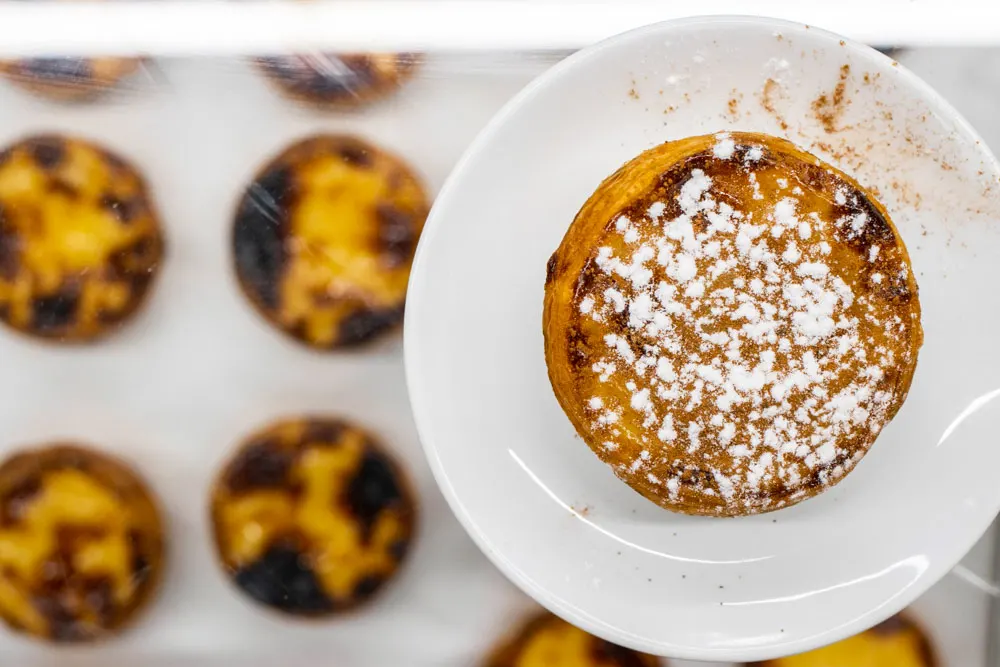
If you only eat one dessert in Portugal, it should be a Pastel de Nata. This simple Portuguese egg tart has conquered the world but it’s best eaten in its home country.
If you’re wondering what differentiates a Pastel de Nata from a Pastel de Belèm, the answer comes down to geography. Unlike a Pastel de Belèm, a Pastel de Nata can be baked anywhere while a Pastel de Belèm is specific to one location.
In Portugal, Pasteis de Nata are baked everywhere and they’re almost always good.
Read our Lisbon Pastel de Nata guide.
17. Queijada de Sintra
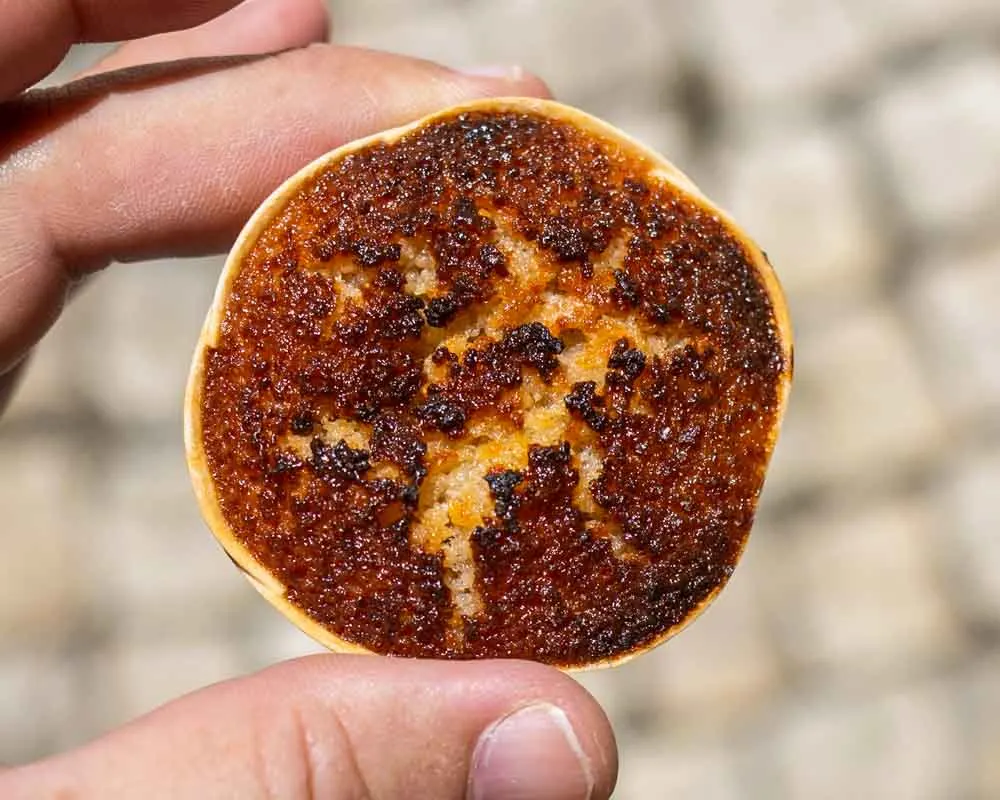
Miniature cheese pastries called Queijadas are available all over Portugal but the most famous ones are baked in Sintra. Besides the cheese that gives Queijadas their name, other ingredients include eggs, sugar, milk and flour.
Eating these little pastries in Sintra is like channeling history. Once used as currency, Queijadas de Sintra date back to the Middle Ages. However, the Sapa family has ‘only’ been baking them since the latter half of the 19th century. Don’t hold that against them as they seem to have sorted out the formula by now.
Pro Tip
Be warned that Queidjas can be addictive. You may want to buy a few extra to enjoy on the train ride back to Lisbon.
18. Indiano
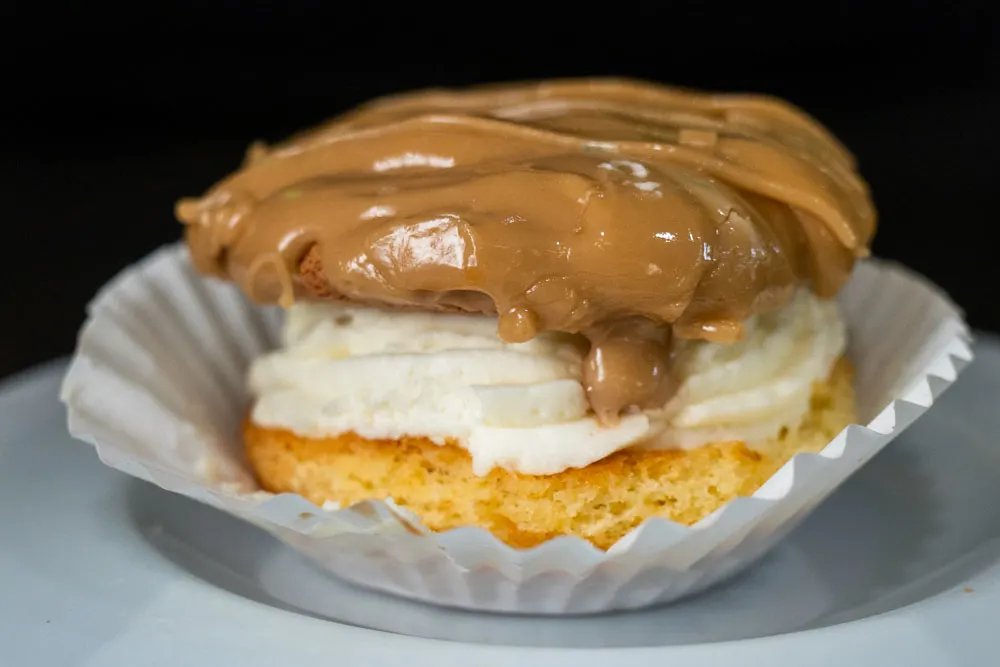
Most Portuguese pastries seem to be available at every single pasteleria. The Indiano is not one of these pastries. In fact, we’re only seen the unique pastry at Versailles and Confeitaria Nacional during our travels around Lisbon.
We’re yet to figure out how the Indiano got its name or why it’s not more popular. Its moist cake base provides a spongey base for cream and icing. We’ve eaten Indianos topped with chocolate, vanilla and coffee icing and have enjoyed them all.
19. Travesseiro (Pillow)
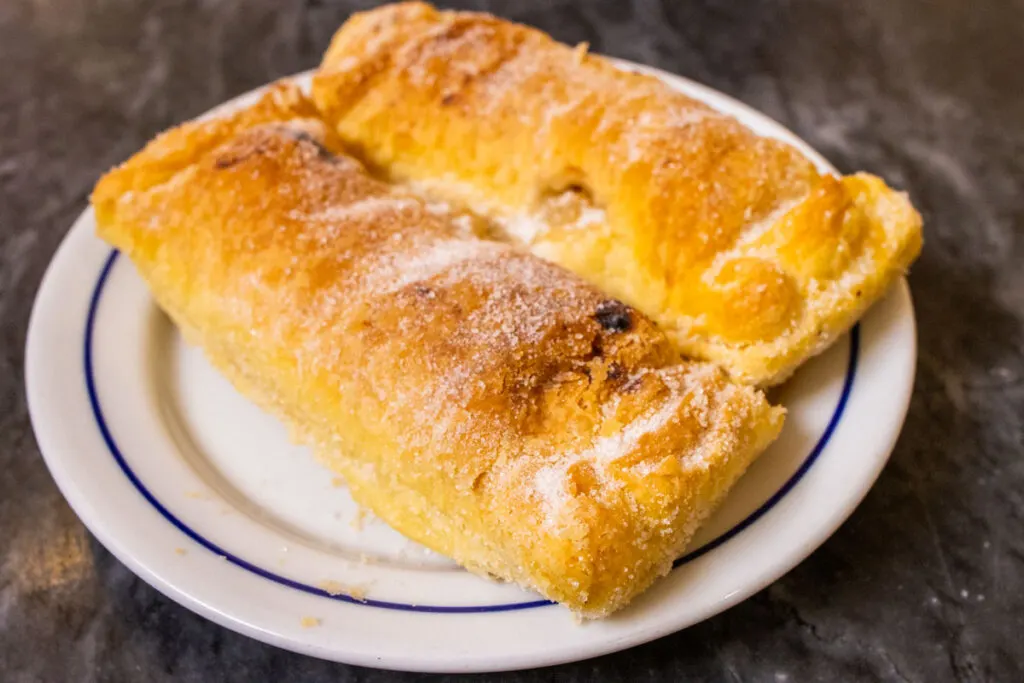
Queijadas aren’t the only pastry that call Sintra home. A second Sintra pasteleria bakes an equally notable pastry called Travesseiro.
Casa Piriquita has been baking pastries since 1862 as they proudly advertise at their Sintra shops. Crowds queue for the chance to eat the pillow-like Travesseiro pastry made with almonds and puff pastry.
Not surprisingly, Travesseiro’s other ingredients include eggs and sugar. This is a Portuguese pastry after all!
Pro Tip
If you’re wondering whether to try a Queijada or Travesseiro when you visit Sintra, the answer is yes. The two pastries are entirely different from each other and they’re both good. The only way to discover your favorite is to give both a try.
20. Queijada de Évora
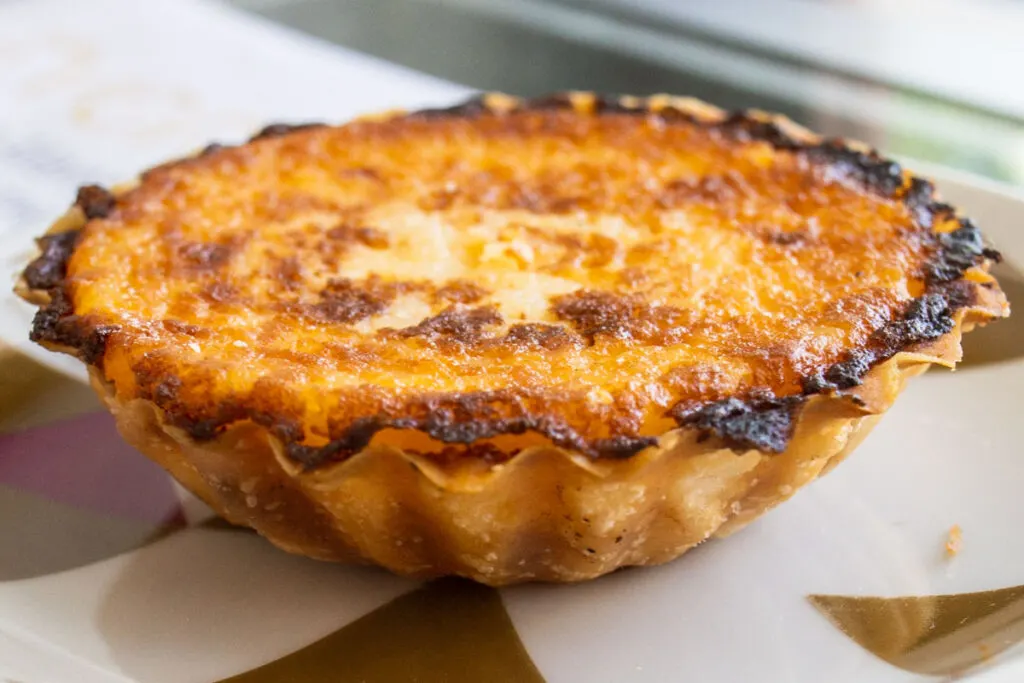
Évora is the most notable city in Portugal’s Alentejo region. Much of its noteriety comes from ancient Roman ruins and historic sites that earned the city its UNESCO status. But the city’s food culture is an equally valid reason for visiting Évora.
Though we could also wax poetically about Alentejo’s viticulture, we’ll save that for a future article. Instead, we’ll instead sing the merits of trying a Queijada de Èvora during your visit. Better yet, try two since the tiny, cheesy pastries feature local sheep’s milk as well as (you guessed it) sugar and eggs.
21. Queijo de Figo (Fig Cheese)
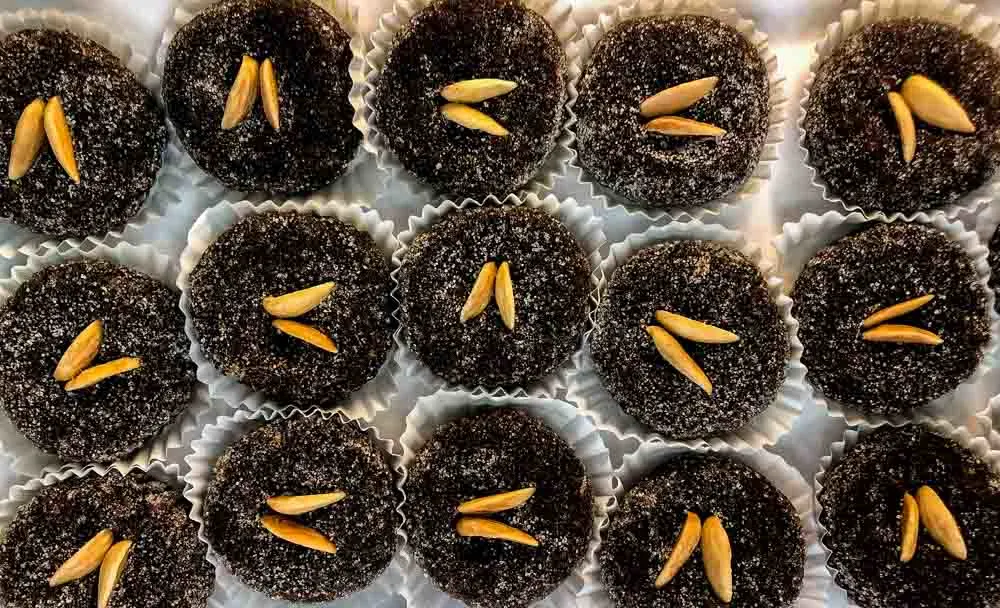
Ironically, Queijos de Figo aren’t made with cheese. They also don’t have any eggs.
Instead, this pastry’s primary ingredients are Algarvian figs and granulated sugar.
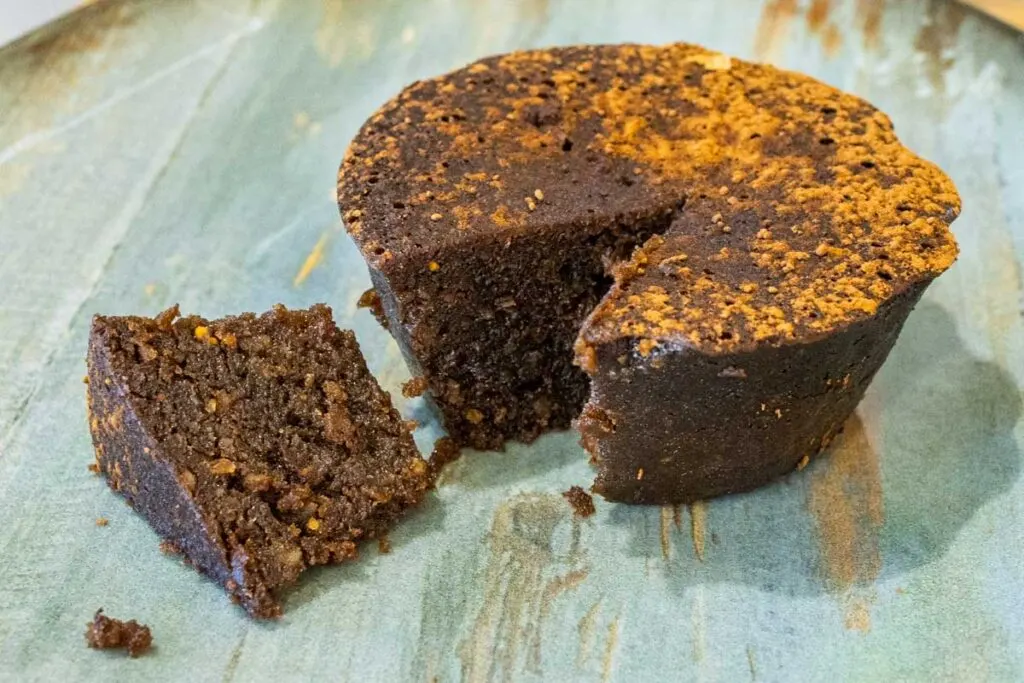
The fig-forward pastry gets its name from those figs as well as its torta cheese-like shape. It also comes in a larger cake version.
22. Torta da Azeitão (Pie of Azeitão)
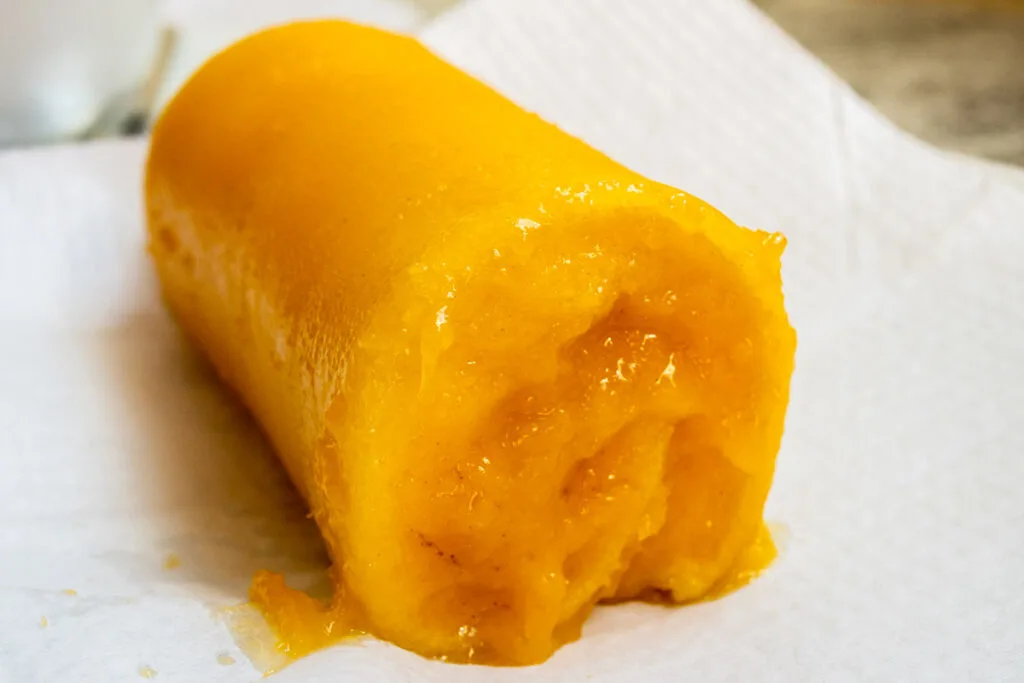
Despite its preponderance of egg yolk, the Torta de Azeitão is different from most traditional Portuguese pastries. But why?
For starters, it’s NOT a conventual pastry and was instead invented at an Azeitão pastry shop. Then there’s its jelly roll like form created with sponge cake and egg cream.
The Torta de Azeitão is fun to eat thanks to its soft texture and flavors like lemon and cinnamon. It especially tastes good when paired with a glass of Moscatel – a special fortified wine produced in the same region where the rolled pastry was invented.
23. Jesuita (Jesuit)
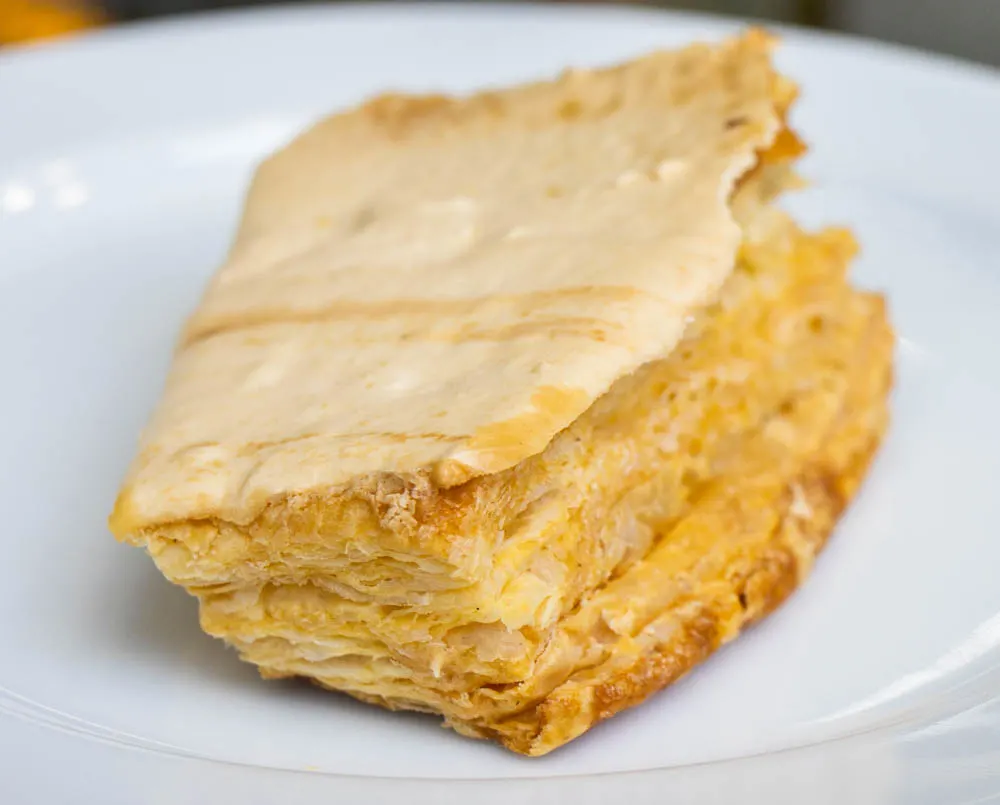
Invented in Santo Tirso near Porto, the Jesuita gets its name from triangular Jesuit habits. Whether covered with sweet icing or almonds, this layered Portuguese pastry is always triangular in shape.
We’ve eaten both Jesuita versions and even tried one layered with apples instead of sweet eggy cream. The pastry’s flakiness distinguishes it from other pastries in the country
24. Ovos Mole de Aveiro (Soft Eggs Of Aveiro)
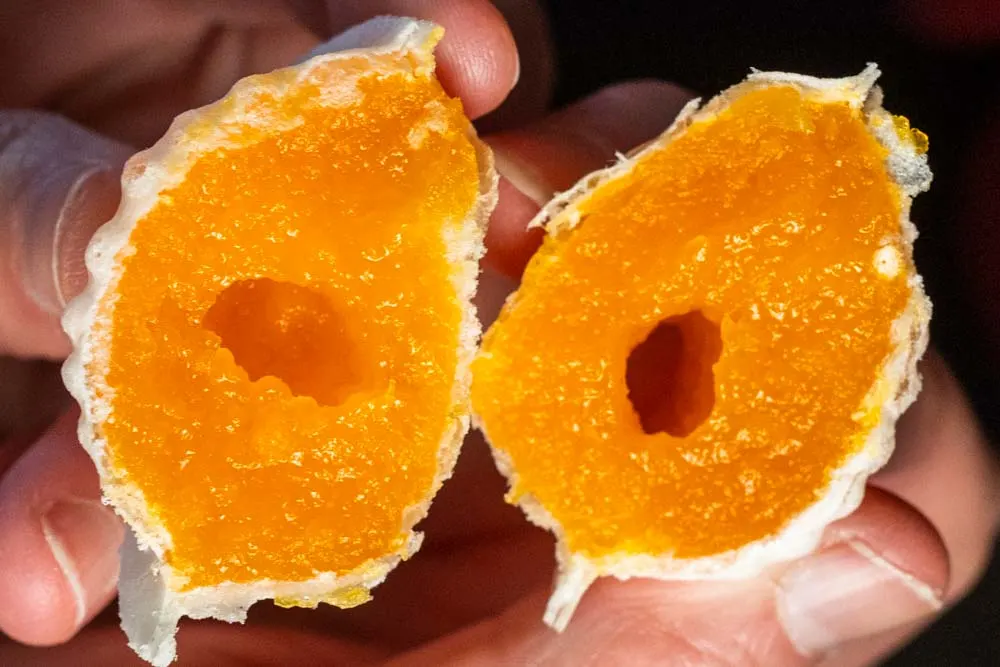
Portugal’s Ovos Mole de Aveiro may be the country’s most unusual pastry to receive protected Protected Geographical Indication status from the European Union. Surrounded by communion wafers, the center of each Ovos Mole has bright yellow, super sweet custard made with a preponderance of egg yolk and sugar.
Although nuns invented Ovos Mole in the town of Aveiro, the dessert is readily available throughout Portugal. Some pastelerias take the extra step of crafting the eggy treats to look like fish and seashells, but a typical Ovos Mole tastes cloyingly sweet regardless of its shape.
25. Pâo de Deus (God’s Bread)

The Pâo de Deus was a pastry that spoke to us before we tasted it. We had high expectations based on its name alone – the Portuguese pastry’s name impressively translates to God’s Bread. As an extra bonus, the pastry enjoys a long history as a treat eaten on All Saint’s Day each year.
After one bite, we quickly realized that the Pâo de Deus’ brioche base is covered with a sweet, eggy coconut topping. Alas, we’re not coconut fans. We still recommend it for those who like brioche, coconut and traditions.
26. Dom Rodrigo
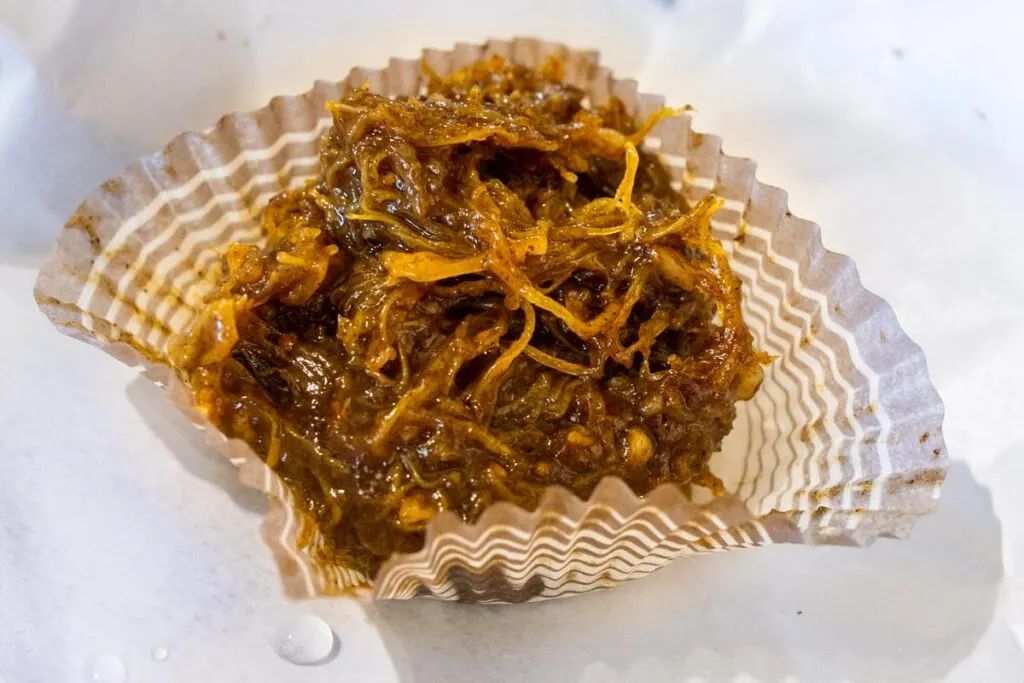
Most Portuguese pastries have a history and the Algarve’s Dom Rodrigo is no exception. However, its story isn’t particularly definitive.
While we know that the origin of the Dom Rodrigo dates back to the 18th century, we’re not sure who invented it. Was it invented by a man named Rodrigo or was it merely named after a man with this surname? And was that man a monk or a wealthy patron or even a military figure? We may never know these answers but we do know a few things…
First, we know that the Dom Rodrigo is popular in Portugal’s southern Algarve region where it was invented. We also know the pastry’s ingredients include almonds, cinnamon, egg yolks and sugary egg yolk threads called fios de ovos. Finally, we know that the ugly yet tasty pastry looks best when it’s wrapped in colorful foil and displayed like a miniature pyramid.
27. Pastel de Tenútgal
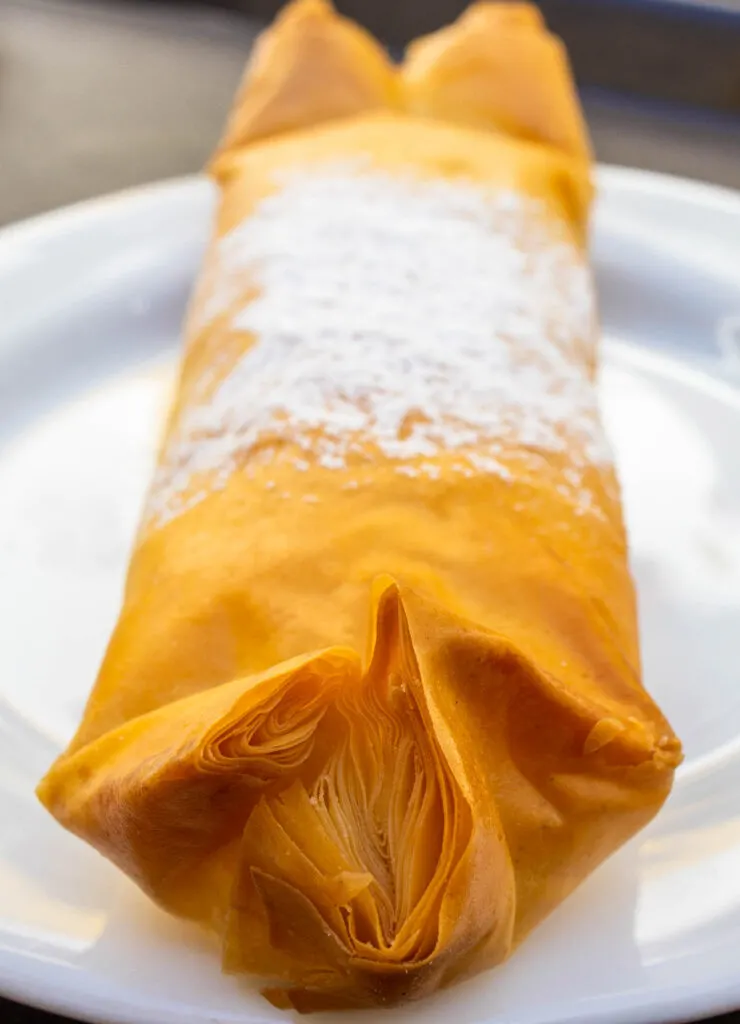
The Pastel de Tenútgal isn’t as famous as the Pastel de Nata but maybe it should be.
Not only does the Pastel de Tenútgal pre-date Portugal’s famous egg tart by two centuries, but it’s also a longer and crispier pastry filled with sweet, creamy doce de ovos. Plus, in a bit of a twist, the clever clergy who created the Pastel de Tenútgal were nifty nuns as opposed to motivated monks.
Hailing from in Tenútgal, a town near the university city of Coimbra, this long, crispy conventual pastry is easy to find throughout Portugal. And, like many of the best Portuguese pastries, it’s a protected dessert with IGP status.
28. Bolo Moscatel (Moscatel Cake)
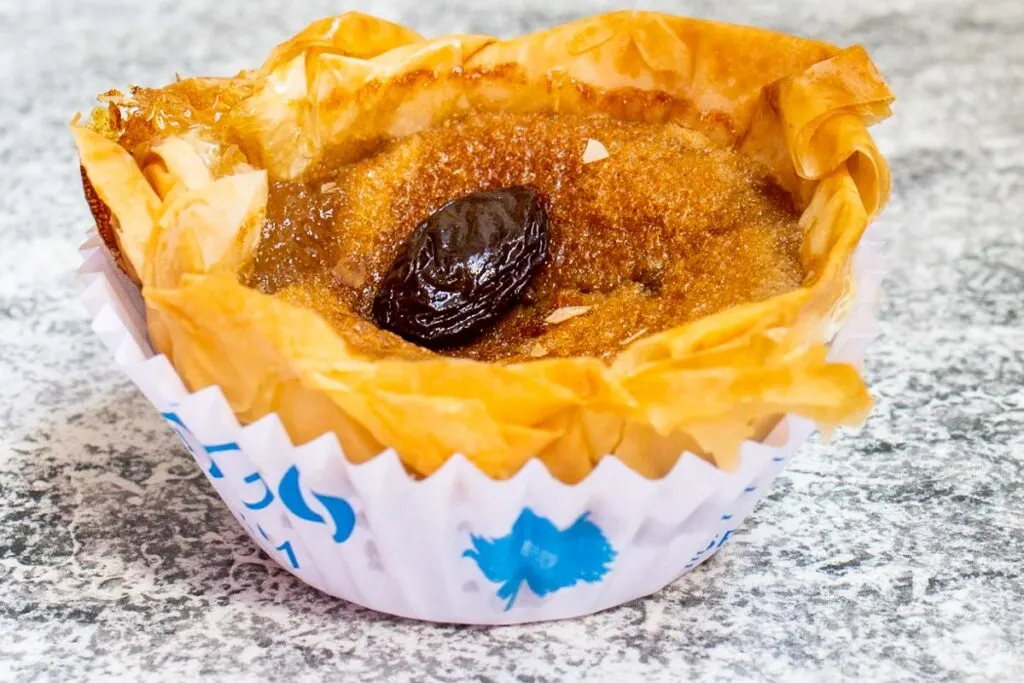
Portugal’s Moscatel may not be as famous as its Port wine, but Setubal’s fortified Moscatel wine is equally enjoyable to sip after dinner. It’s also a fine pastry ingredient as evidenced by the Bolo Moscatel.
In fact, we prefer Pastelaria Cego’s Bolo Moscatel over the Azeitão bakery’s more famous Torta de Azeitão. With its satisfying dried fruit flavor of moscatel raisin in the middle, this crispy, crunchy pastry hits our sweet spot.
29. Queijinho de Ceu (Cheese from Heaven)
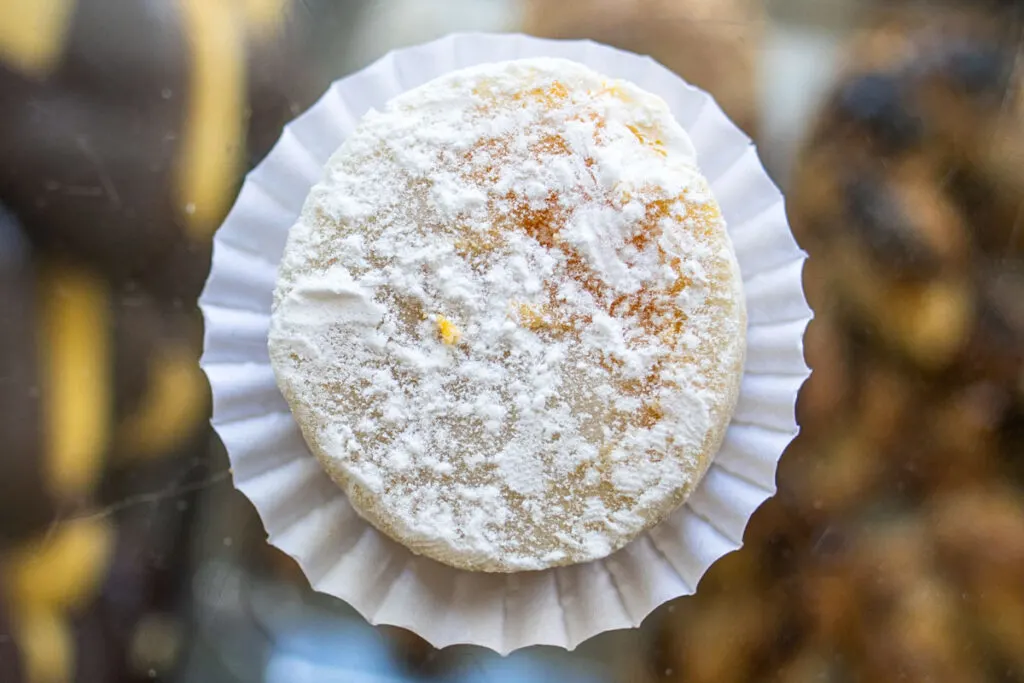
Although Queijinho de Ceu literally translates to cheese of heaven, this heavenly pastry doesn’t contain any cheese. Instead, it’s made with grated almonds, dusted with powdered sugar and filled with doce de ovos.
The pastry’s name is a nod to its shape in lieu of its recipe. We wouldn’t mind if the Queijinho de Ceu’s recipe actually included cheese. But we also don’t mind that it doesn’t.
30. Queijada De Feijão
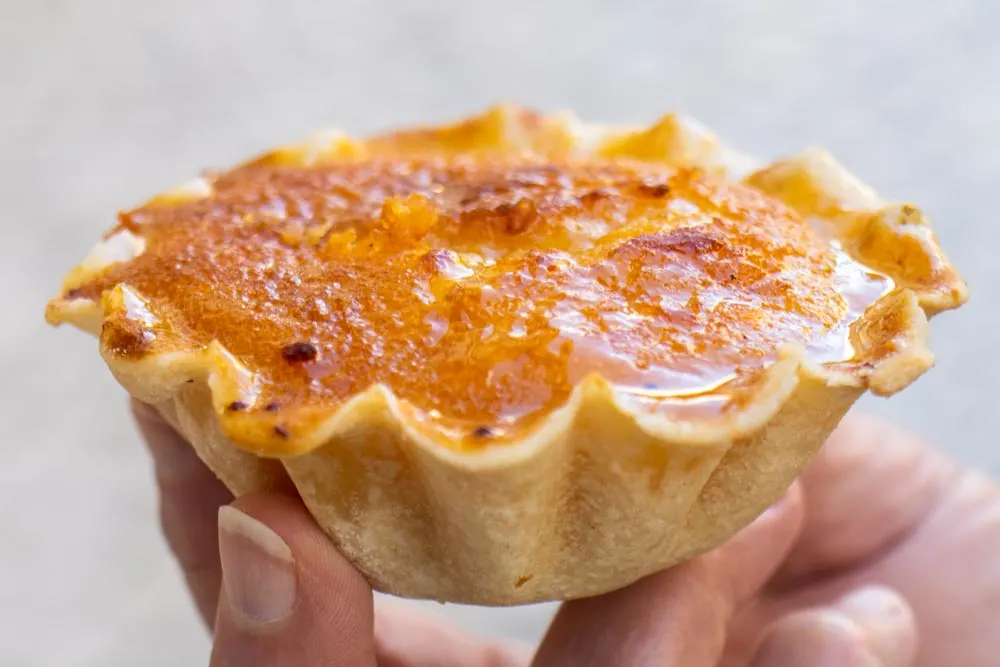
Not to be confused with the Queijadas produced in Sintra and Évora, the Queijada de Feijão doesn’t have cheese in its ingredient list. Instead, this classic Portuguese pastry adds white beans and ground almonds to its sweet eggy paste.
Although Joaquina Rodrigues garners respect for inventing Portugal’s iconic bean cake in her home city of Torres Vedras during the late 19th century, dessert eaters don’t have to travel to central Portugal to sample a Queijada de Feijão. Most neighborhood pastelerias serve this pastry in Lisbon as well as in other cities throughout Portugal. It’s that popular.
Pro Tip
Stop by Fábrica do Pastel de Feijão if you’re walking around Alfama in Lisbon and want to try a more modern bean cake. However, be aware that opening hours are currently limited.
31. Morgadinho
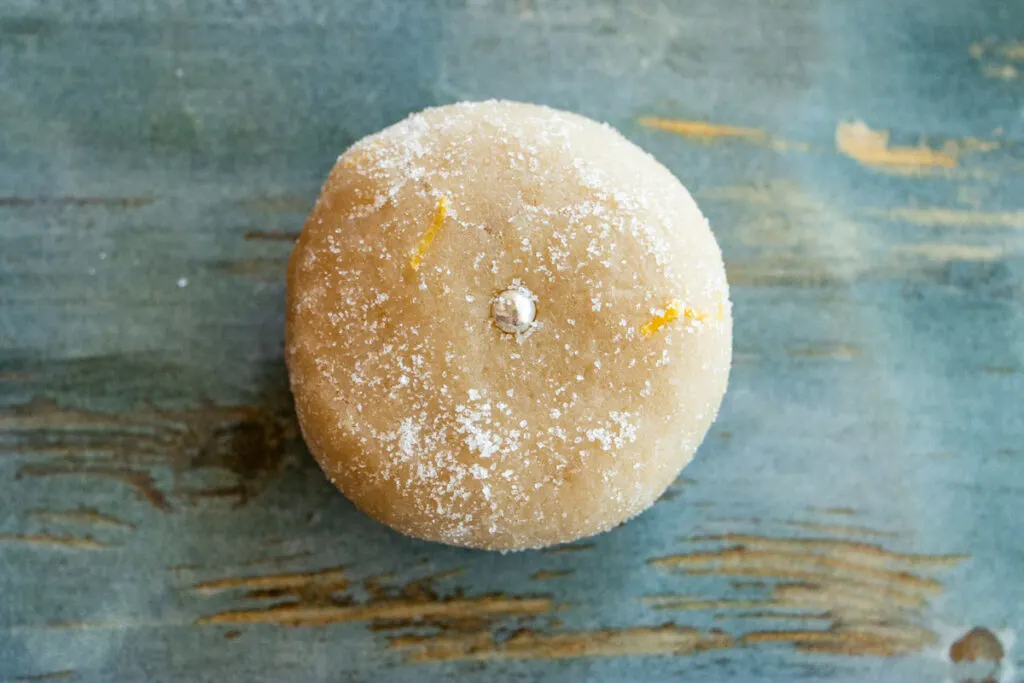
With its white fondant coating and a silver dragee (silver ball bearing) on top, the Morgadinho looks like a simple sweet. However, in the case of this Algarvian delicacy, looks can be deceiving.
One bite into a Morgadinho reveals a different flavor from other popular Portuguese pastries – pumpkin. Don’t worry, the Morgadinho still has enough egg yolk and sugar to make it taste Portuguese.
32. Barriga de Freira (Nun’s Belly)
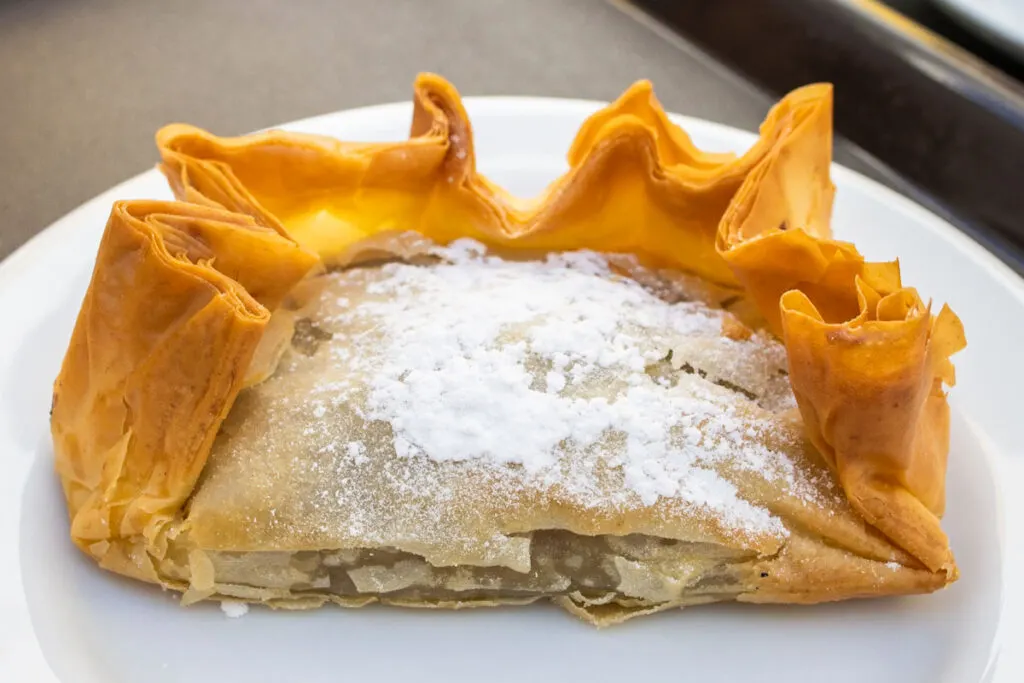
The Barriga de Freira stands out from other Portuguese conventual pastries because of a name that literally translates to nun’s belly. Talk about a name that combines religion and humor in one fell swoop!
Typically enjoyed during the Christmas season, many of the Barriga de Freira’s ingredients will seem familiar. They include sugar, butter, ground almonds and, of course, egg yolks.
Discover more Christmas desserts eaten around the world.
33. Bolo de Arroz (Rice Cake)
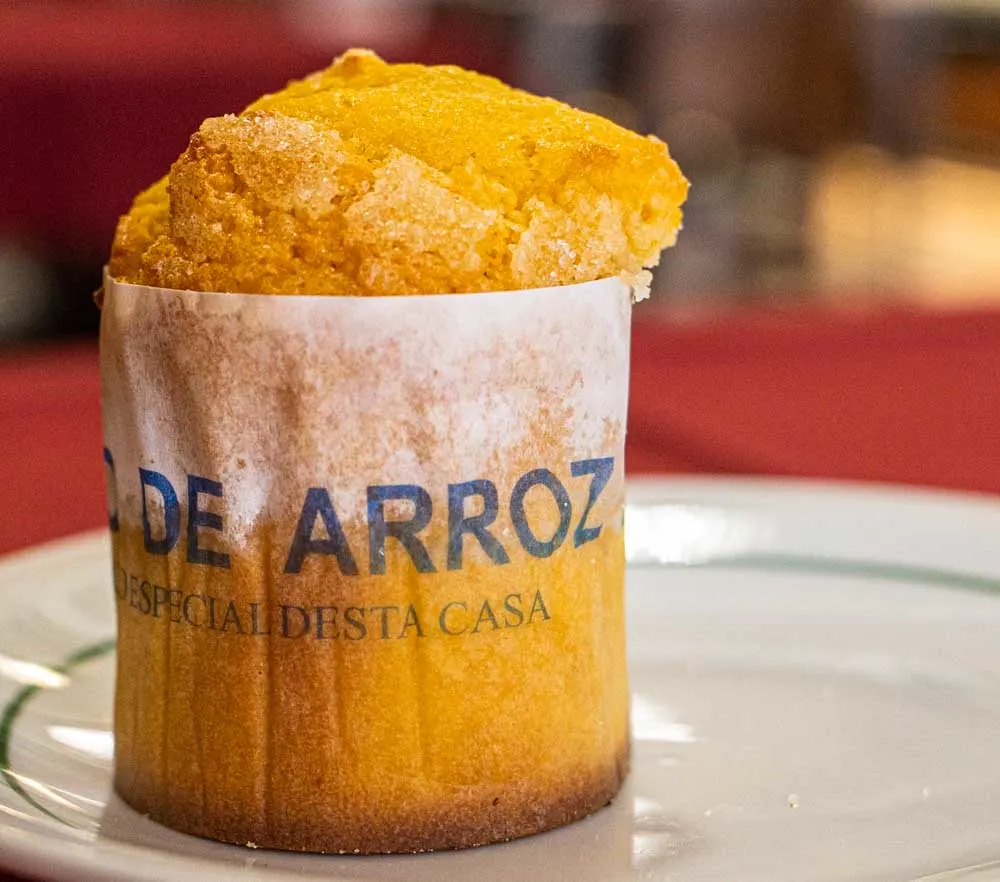
Bolo de Arroz, which translates to rice cake, likely got its name from one specific ingredient – rice flour. A staple of Portuguese pastelerias, it’s an anomaly among its pastry peers. Despite having a crispy top layer sprinkled with sugar, this Portuguese pastry is as savory as it is sweet.
Although the Bolo de Arroz recipe doesn’t include corn meal in addition to rice flour, we liken the Portuguese pastry to an American corn muffin. The textures are similar and neither is too sweet.
International Pastries In Portugal
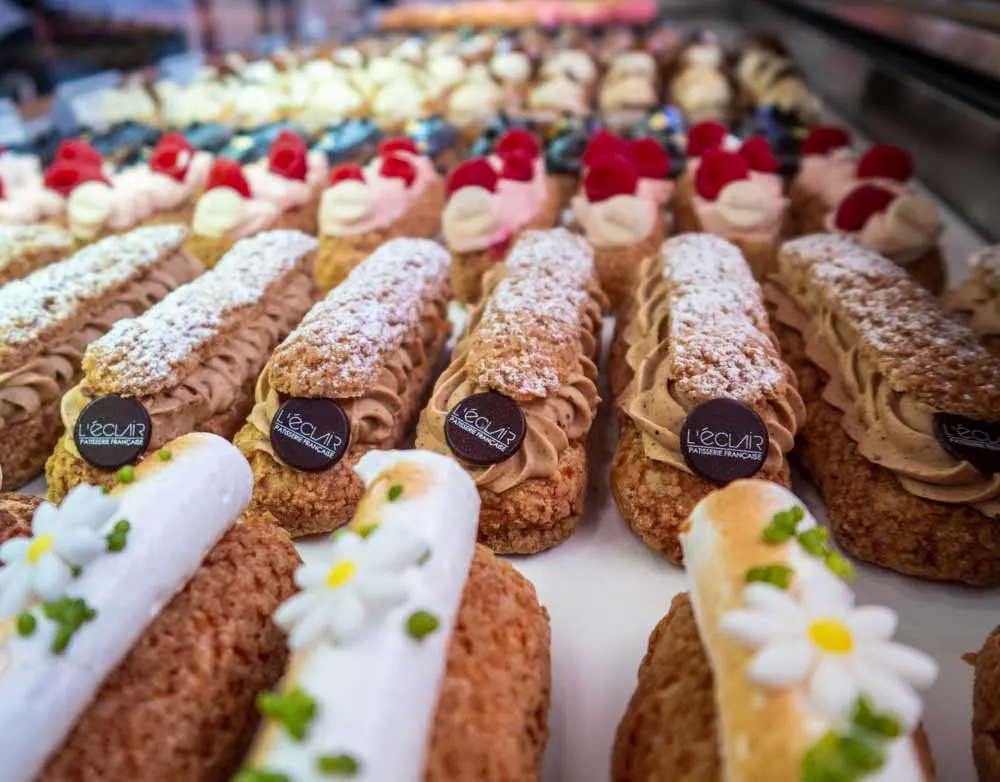
Since there’s a limit to the amount of traditional Portuguese desserts and pastries that we can eat, sometimes we want something different. Luckily, we have no problem in this scenario since many of the most popular Portuguese pastries originated in other countries.
Just like Portugal left its culinary mark in countries around the word, other countries have influenced Portuguese cuisine. Beyond savory food like hamburgers and pizza, Portuguese people have added several global desserts to their diet.
These are our favorite international sweet treats to eat in Portugal:
34. Eclair
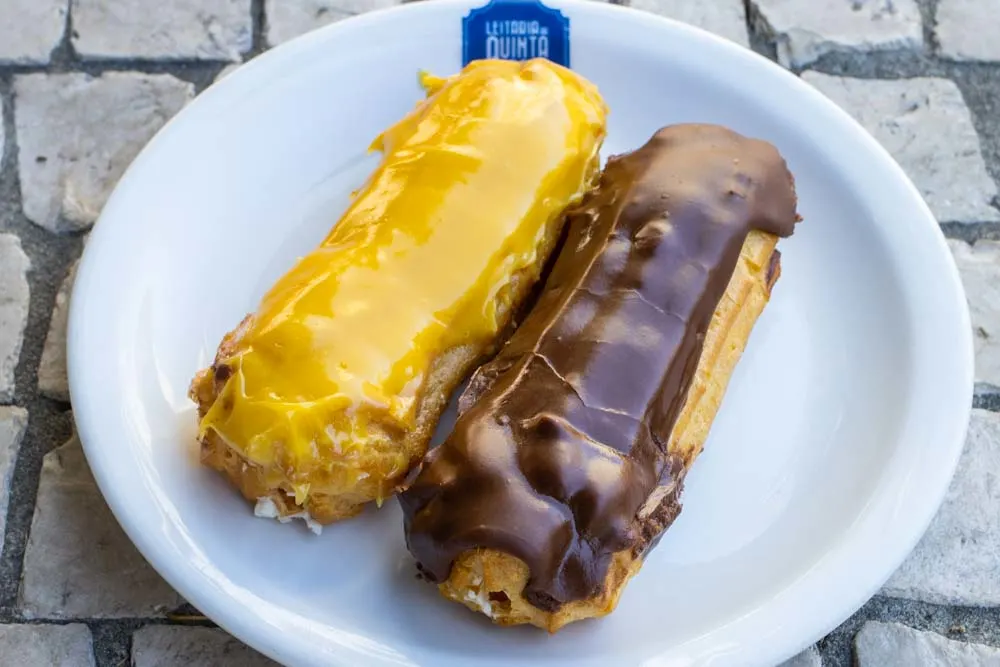
The French may have invented Éclairs in the mid 19th century, but the Portuguese have made the oblong French pastry their own. We found this concept odd until we bit into our first Portuguese Éclairs at Leitaria da Quinta do Paço in Porto and then it all made sense.
Discover more Porto food favorites.
Leitaria da Quinta do Paço has been filling Éclairs with fresh chantilly cream and topping them with milk chocolate since the 1920s but they don’t stop there. Other flavors run the gamut though our favorites are lemon and croquant.
Warning
Once you eat an Éclair at Leitaria da Quinta do Paço, you’ll develop a sweet addiction that can only be satisfied with more Éclairs. The dairy has multiple locations in Lisbon, Braga and Porto to satisfy this addiction. In case you can’t tell, it’s one of our favorite pastry shops in Portugal.
35. Bola de Berlim
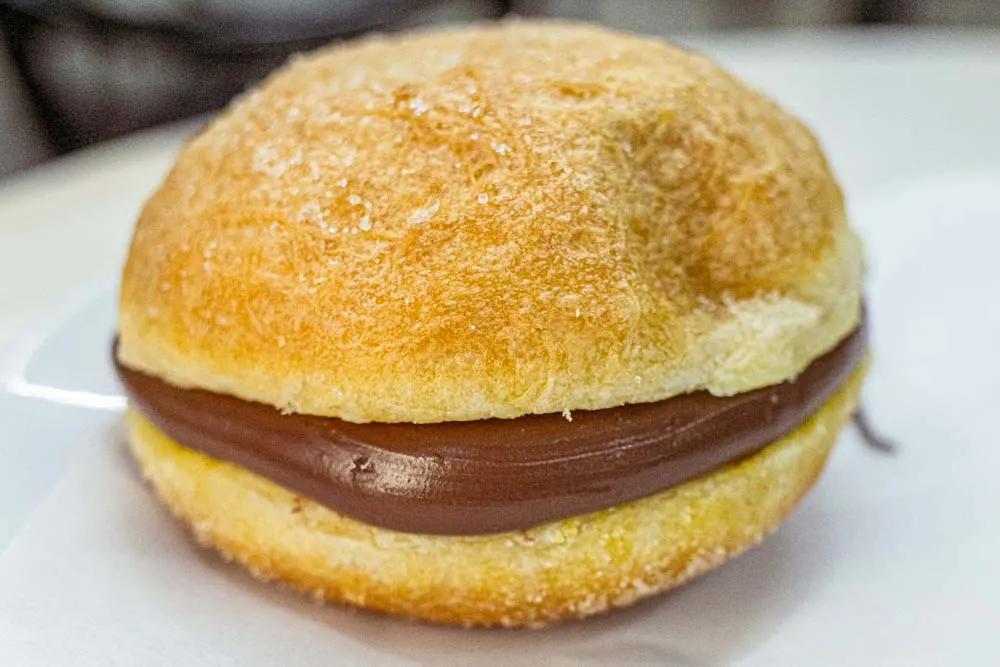
Traveling donut fans can satisfy their donut cravings in Portugal by eating a Bola de Berlim. However, these Portuguese pastries aren’t related to American donuts. Instead, immigrants brought the concept from Germany almost a century ago.
Discover more great donuts eaten around the world.
A Portuguese Bola de Berlim is bigger and sweeter than a jam-filled Berliner in Berlin. Although doce de ovos, a sweet cream made with egg yolks and sugar is the typical filling, we prefer chocolate inside our fried bundles of joy.
Pro Tip
You can find Bola de Berlim at pastelerias, train stations and even at the beach.
36. Brigadeiro
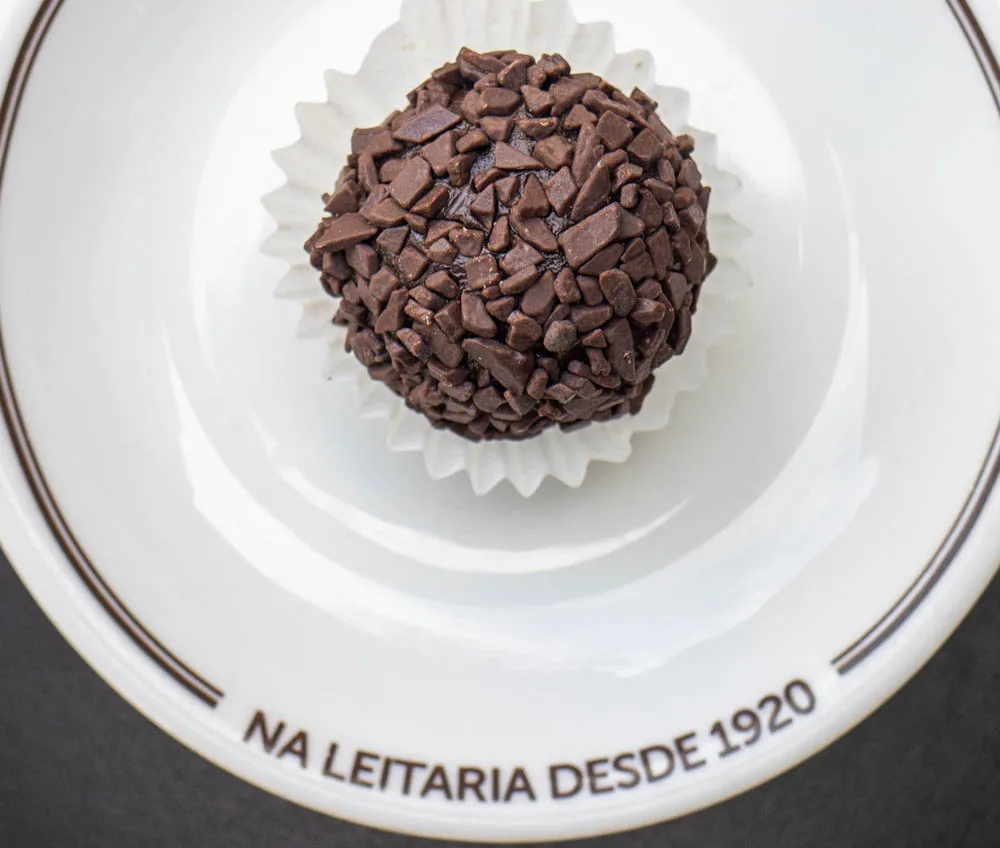
Portugal and Brazil have a symbiotic relationship that transcends the two counties’ intertwined past and shared language. Though they’re separated by an ocean and 8,000 kilometers, certain Brazilian foods are readily available in Portugal. These foods include sandwiches, Feijoada and Brigadeiros.
Invented in Rio de Janeiro and named after a Brazilian politician, Brigadeiros are easy to find in Portugal. The pastry’s traditional recipe includes condensed milk, cocoa powder and butter plus chocolate chips to coat the balls. Don’t worry if you don’t like chocolate – Portuguese pastry chefs create Brigadeiros in a rainbow of flavors besides chocolate.
37. Cinnamon Bun

We’ve eaten cinnamon buns around the world but many of our favorites have been in Scandinavia. With that in mind, it should be no surprise that the little cardamom and cinnamon cakes at Lisbon’s Copenhagen Coffee Lab, one of Lisbon’s best coffee shops, make us happy.
While we refer to cinnamon buns as Korvapuusti in Helsinki and Kanelbullar in both Sweden and Norway, we choose to call them Danishes when we eat them in Lisbon. We called them Kanelsnegle in Copenhagen when we finally made it to Denmark but you have to admit that calling them Danishes is more fun.
Discover more cinnamon buns around the world.
38. Chocolate Chip Cookie

The Chocolate Chip Cookie is having its moment in Europe. Not only have we eaten elevated cookies at Paris coffee shops and restaurants, but we regularly eat amazing chocolate chip cookies at Milkees, one of our favorite Lisbon cafes.
Brazilian baker Joāo Pedro Erthal bakes the classic American cookie in Portugal – and it’s as good as any cookies we’ve eaten in the USA. If there’s a more international pastry in Portugal, we have yet to find it.
39. Croissant
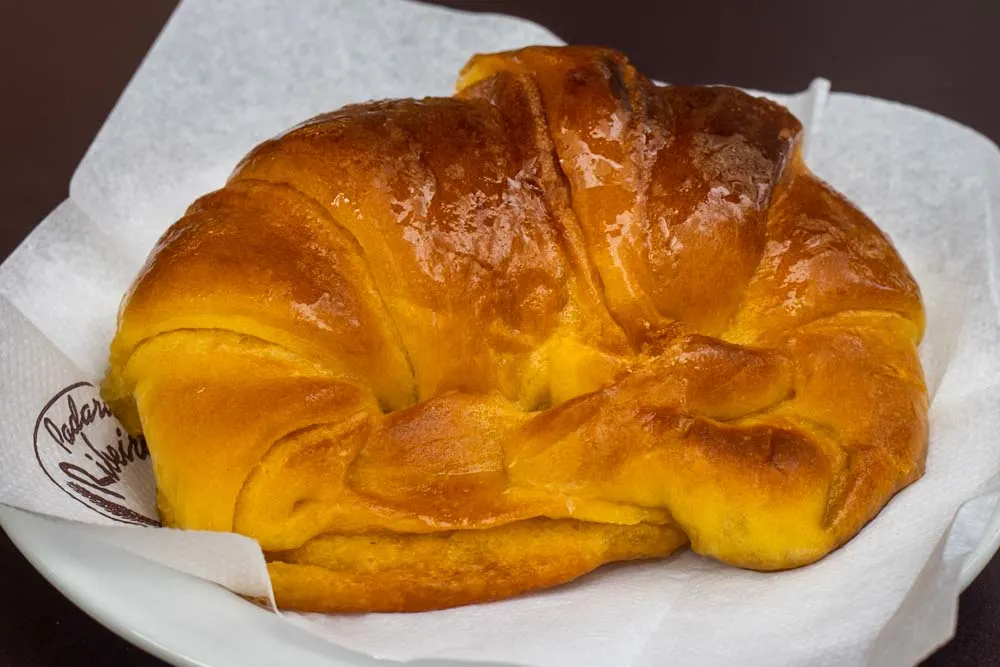
Although France is inexorably connected to the Croissant, the European country can’t claim credit for inventing the crescent-shaped rolls. That credit goes to Austrians who invented the Kipferl in Vienna. The French also can’t keep the croissants within their borders. Italians bake a version called a Cornetto. In Portugal, it’s just called a Croissant.
As is the case with most Portuguese pastries, Portuguese Croissants are sweeter, heavier and doughier than their French brethren. Even plain ones get a sprinkling of powdered sugar… and then there are Croissants filled with doce de ovo at spots like Croissant de Sesimbra in our first Lisbon neighborhood. Oh my!
40. Palmier
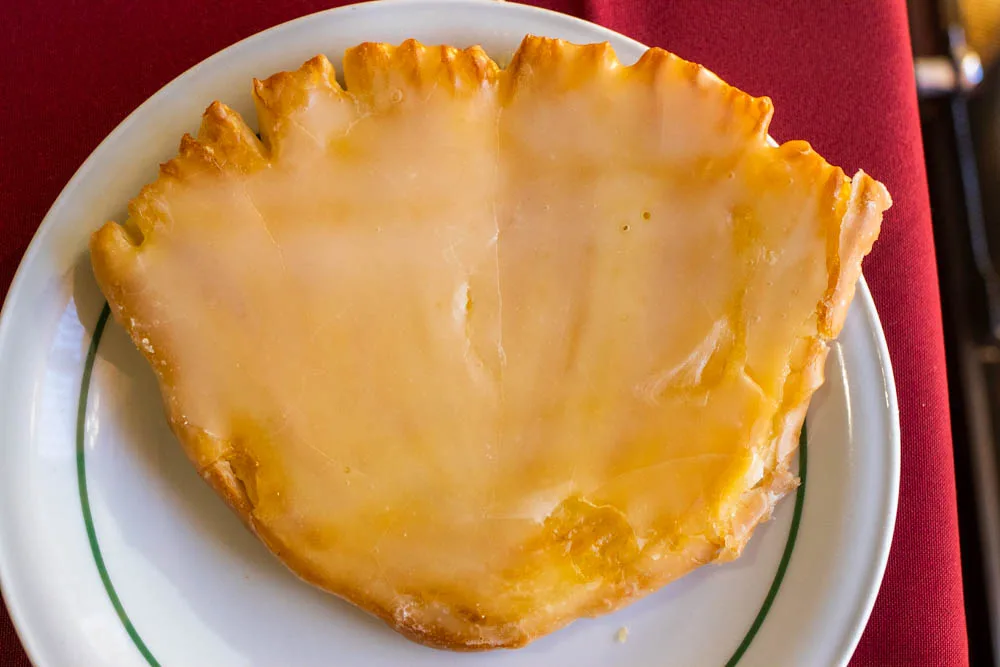
Palmiers have different names around the world. Spaniards call the French pastry Palmeras while Mexicans call them Orejas. Mindi grew up calling them Elephant Ears. In Portugal, they’re called Palmiers just like in France. However, they’re not exactly the same.
While the French make palm-leaf shaped Palmiers with puff puff pastry and sugar, Portuguese bakers take the pastry one step further by making versions with sweet icing or filling them with ovos de doce. Sure, you can eat a plain Palmier in Portugal. But where’s the fun in that?
41. Salame de Chocolate (Chocolate Salami)
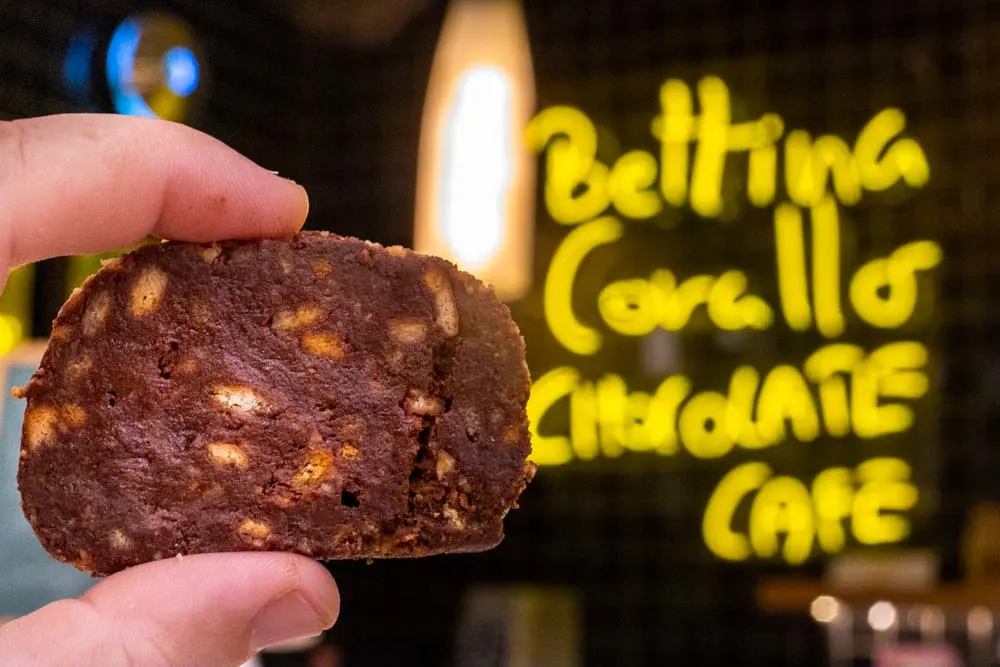
Portuguese people love their cured meat, especially Presunto Porco Preto made from special black pigs. They also love desserts shaped like cured meat but made with chocolate.
Salame de Chocolate is actually an Italian creation that made its way to countries like Greece and Lithuania. With ingredients like cocoa, cookies, nuts, eggs and butter, it’s no surprise that Salame landed in Portugal too.
42. Chuuros
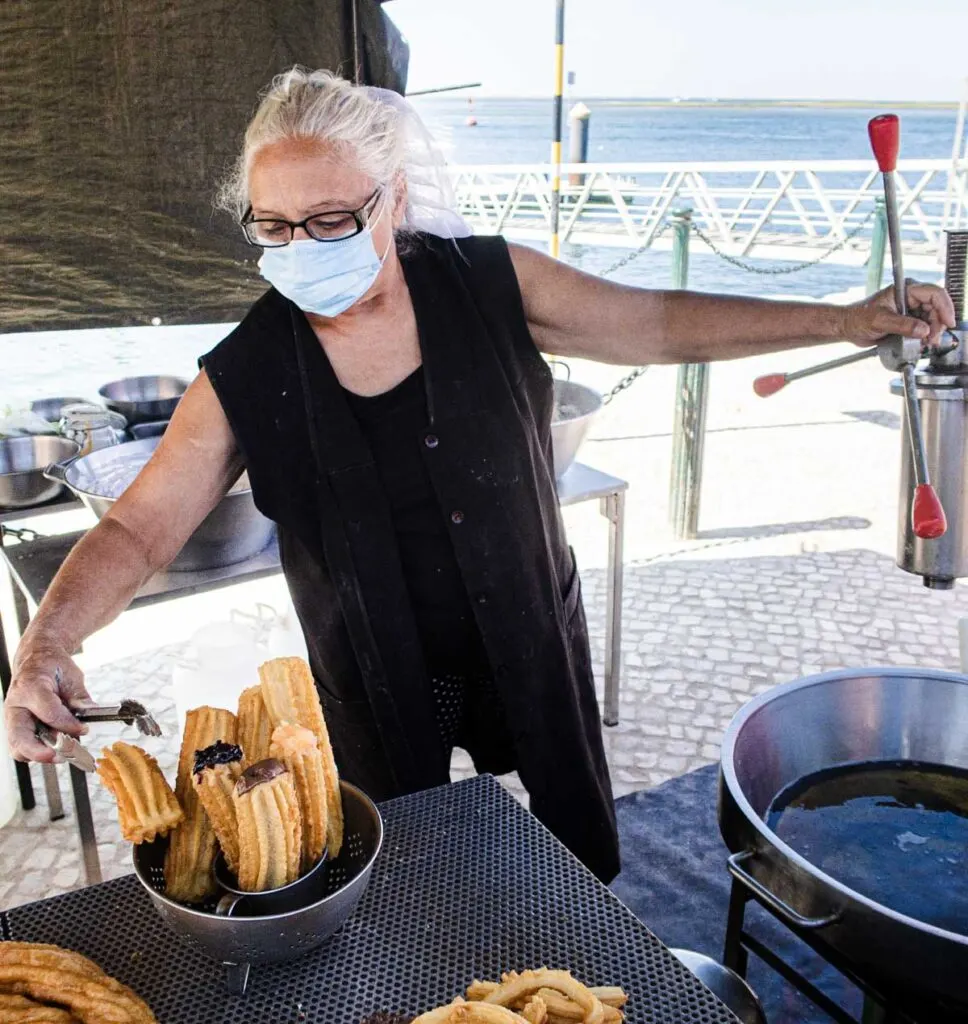
Churros aren’t typically associated with Portugal but maybe they should be.
Not only have the Portuguese been eating the fried pastry dough for centuries, but they may have introduced the churro (by way of Asia) to the rest of Europe. Other food historians argue that the churro has been around since the first century and give that credit to Spain.
Today, you can find a churros stand in Portugual if you look hard enough. We’ve found excellent churros at Lisbon’s Cais do Sodre metro station as well as in the Algarve at Olhão’s Saturday market.
Bonus Portuguese Dessert
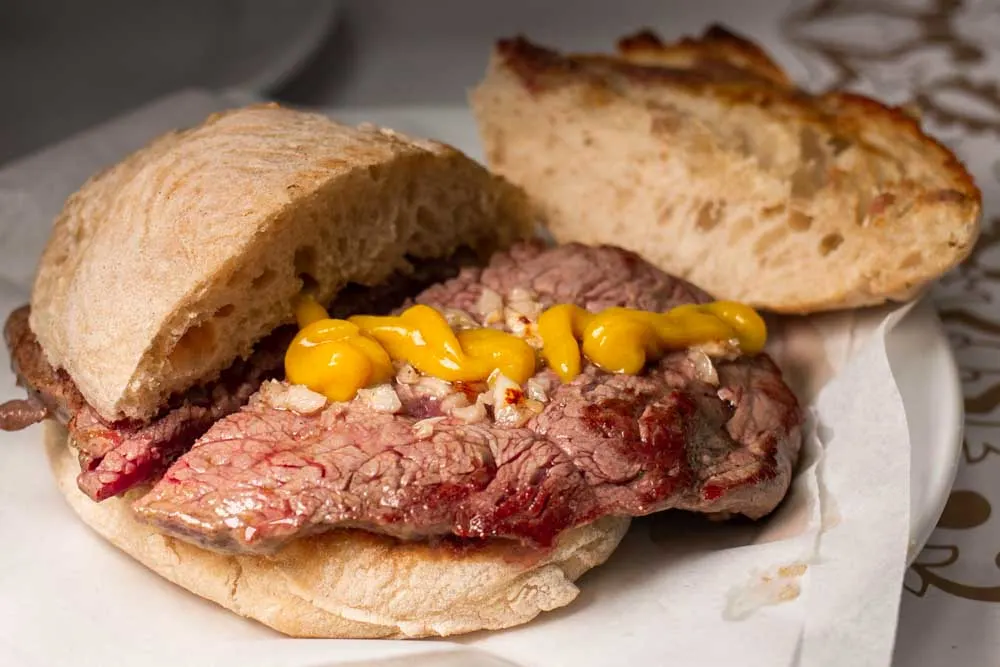
Lisboetas don’t end meals at Cervejaria Ramiro with sweet desserts. Instead, we order savory Prego Sandwiches at the iconic Lisbon marisqueira. Yes, steak sandwiches are the preferred dessert at Lisbon’s most popular seafood restaurant.
It may sound weird, but ordering a garlicky Prego Sandwich is the traditional and best way to end a meal at Ramiro. Squeeze some yellow mustard or add a few drops of spicy piri piri sauce to the sandwich and you’ll be eating one of the most unique Portuguese desserts without risking a sugar high.
Check out our guide to eating in Portugal as well as our picks for the best Portuguese foods before your trip.

About the Authors
Daryl and Mindi Hirsch
Saveur Magazine’s BEST TRAVEL BLOG award winners Daryl and Mindi Hirsch share their culinary travel experiences and recipes on the 2foodtrippers website. Since launching the site in 2012, they’ve traveled to over 40 countries in their quest to bring readers a unique taste of the world.
Original Publication Date: December 5, 2020

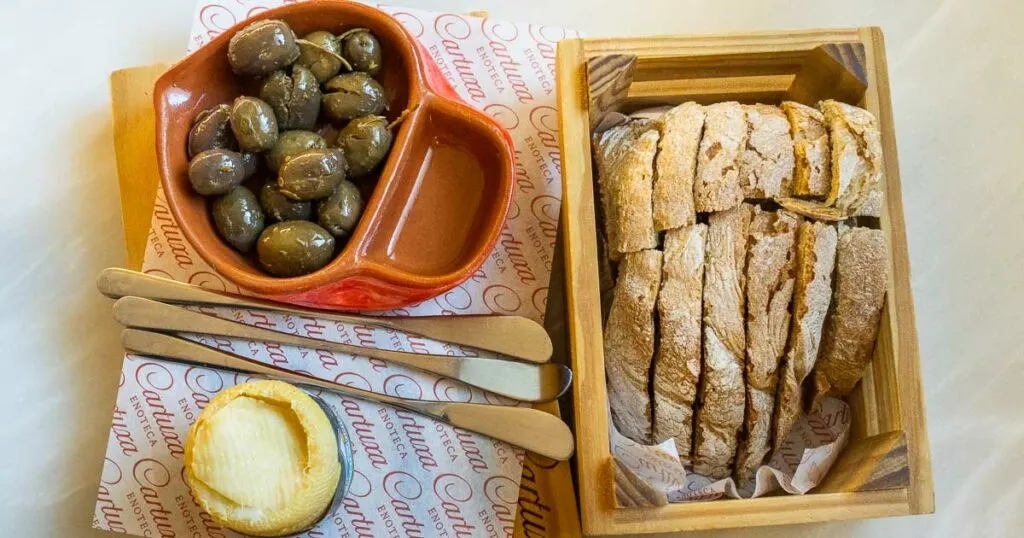
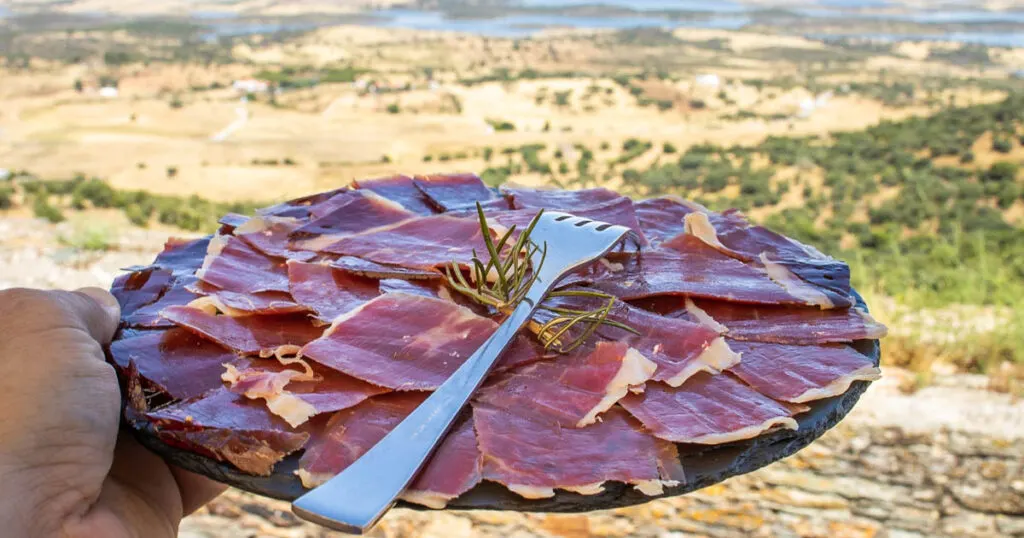
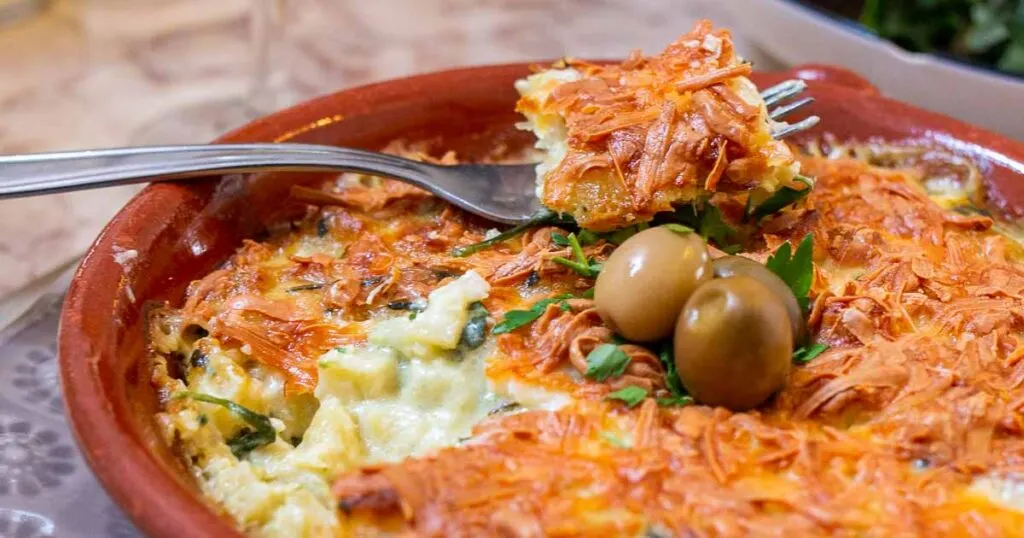
James
Monday 20th of November 2023
It's worth noting that both Salame de Chocolate (Chocolate Salami) and Churros are desserts claimed as invented in Portugal. Portugal disputes with Spain and China for the origin of Churros, and the dispute for Chocolate Salami is between Italy and Portugal!
Joana
Monday 21st of August 2023
As it looks you are living in Portugal there are other desserts you can try in restaurants: serradura, molotof, baba de camelo, doce da avó and pudim de ovos.
Jakob
Friday 3rd of February 2023
That you can eat something in Portugal doesn't quite make it Portuguese. "Kanelsnegle" for instance, while in some ways similar to Portuguese pastry, isn't Portuguese.
As far as I can tell, it is in fact mainly Swedish. The Swedes even have a special day for them once a year.
Variations have become very popular in the other Nordic countries and have, of course, been exported to other countries around the World.
Deborah Jeter
Thursday 10th of February 2022
I am curious about all the recipes planning to try as many as I can smo
Dulce Margarida Rodrigues da Silva
Wednesday 8th of December 2021
Just a hint, you did forget to go trough "pão de ló" that can have a lot of variations worth a try. You can start with Alfeizerão and Ovar. Ofcourse we have a lot more, since almost every city has its own elected sweet, but its Impossible to go trough everything... However, Prego os not a dessert... Its a complement for a meal, so that you won't be hungry. We use that too, but usually not in restaurants. In the end of special meals we may like to stay at the table enjoying the smalltalk with the good company of cheese, wine, special drinks (port, wisky...) or coffee... but always after desert!